Budget Wireless (Wi-Fi) Autonomous System (from the battery) video surveillance

Task:
A budget wireless autonomous video surveillance system for monitoring the current situation on the construction site with the ability to quickly transfer IP cameras to different locations and install elements without interrupting services.
Decision:
Video surveillance system with elements that support wireless data transmission technology: IP video recorder with Wi-Fi + monitor, IP cameras with Wi-Fi and battery power, video server with storage system (optional, wired connection).
This article is not an advertisement for a particular brand, specific items or software. In fact, it turned out that the equipment described below was used to solve the problem with conditions from the Customer - an inexpensive, easy to set up and stable system.
')
The solution scheme.

Description of the elements of the current solution:
DS-N304W IP DVR:
IP DVR - description of parameters
Video / audio input
Video compression format: H.265 / H.264.
IP cameras: 4 channels.
Incoming bandwidth: 50 MB / s.
Video / audio output
Video output: 1 HDMI, 1 VGA.
Resolution of the HDMI / VGA output: 1920x1080 / 60Hz, 1280x1024 / 60Hz, 1280x720 / 60Hz, 1024x768 / 60Hz.
Audio output: 1 channel, RCA (Linear, 1 KΩ).
Record
Number of threads: 2.
The main stream: 5Mp / 4Mp / 3Mp / 1080p / 1.3Mp / 720p.
Stream type: Video, video and audio.
HDD
SATA: 1 SATA.
Volume up to 6 TB each.
Interfaces
Network interface: 1 RJ-45 10M / 100M Ethernet.
USB interface: 2 USB 2.0.
Wi-Fi
Wi-Fi standard IEEE802.11b / g / n.
Frequency range: 2.4 GHz.
Antenna: 2 x 2MIMO external antennas. Supports PA and LNA modules.
Transmission speed: 300Mbps.
Are common
Power supply: DC12V.
Power consumption: up to 18W (without HDD).
Operating conditions: -10 ° C— + 55 ° C, humidity 10% ~ 90%.
Size: 205 × 205 × 45 mm.
Weight: ≤1 kg (Without hard drives).
Video compression format: H.265 / H.264.
IP cameras: 4 channels.
Incoming bandwidth: 50 MB / s.
Video / audio output
Video output: 1 HDMI, 1 VGA.
Resolution of the HDMI / VGA output: 1920x1080 / 60Hz, 1280x1024 / 60Hz, 1280x720 / 60Hz, 1024x768 / 60Hz.
Audio output: 1 channel, RCA (Linear, 1 KΩ).
Record
Number of threads: 2.
The main stream: 5Mp / 4Mp / 3Mp / 1080p / 1.3Mp / 720p.
Stream type: Video, video and audio.
HDD
SATA: 1 SATA.
Volume up to 6 TB each.
Interfaces
Network interface: 1 RJ-45 10M / 100M Ethernet.
USB interface: 2 USB 2.0.
Wi-Fi
Wi-Fi standard IEEE802.11b / g / n.
Frequency range: 2.4 GHz.
Antenna: 2 x 2MIMO external antennas. Supports PA and LNA modules.
Transmission speed: 300Mbps.
Are common
Power supply: DC12V.
Power consumption: up to 18W (without HDD).
Operating conditions: -10 ° C— + 55 ° C, humidity 10% ~ 90%.
Size: 205 × 205 × 45 mm.
Weight: ≤1 kg (Without hard drives).
Photos out of the box:

Rear ports:
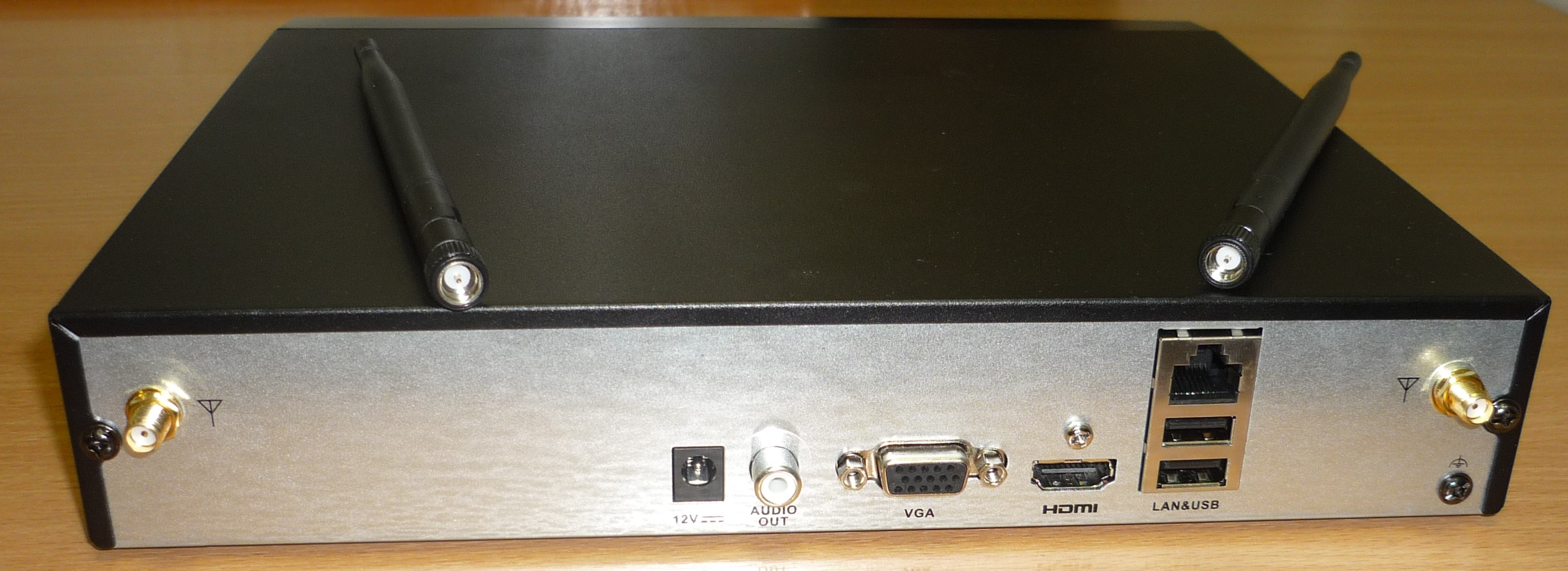

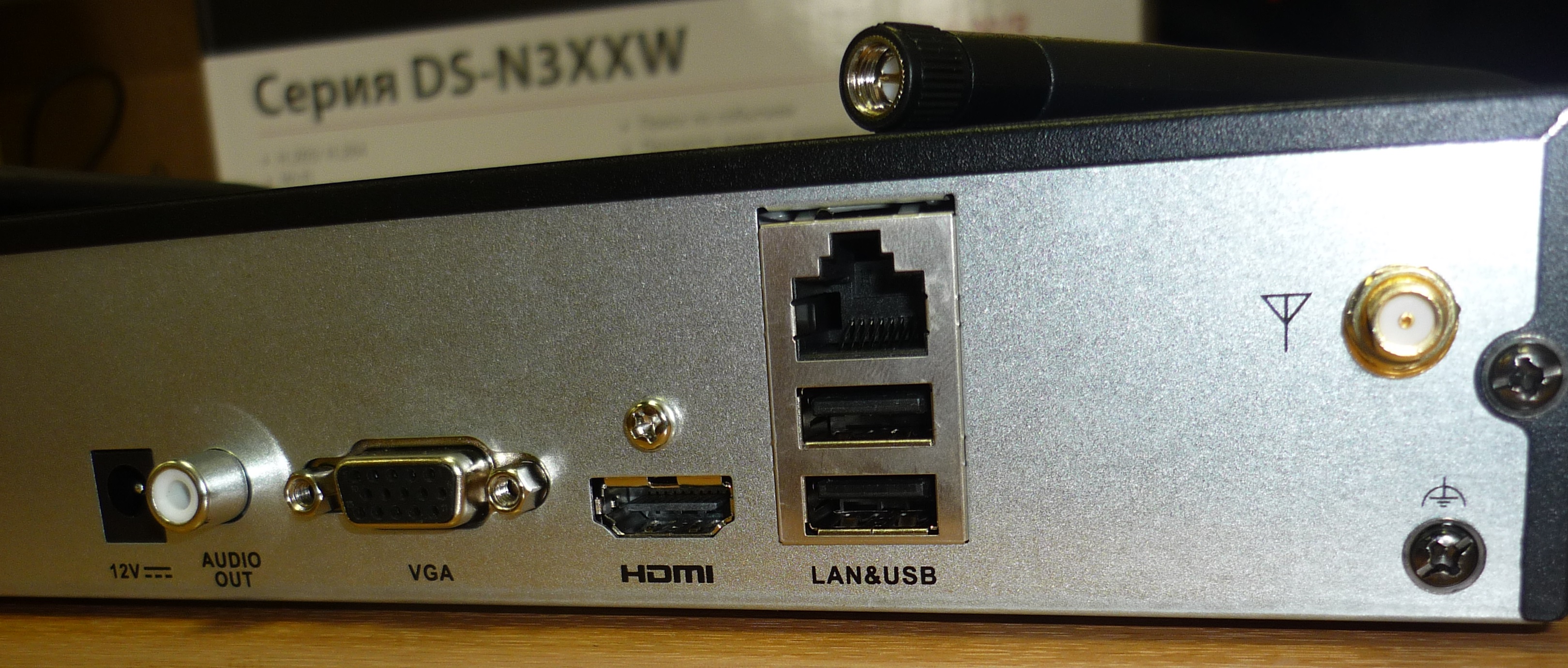
Under the lid:
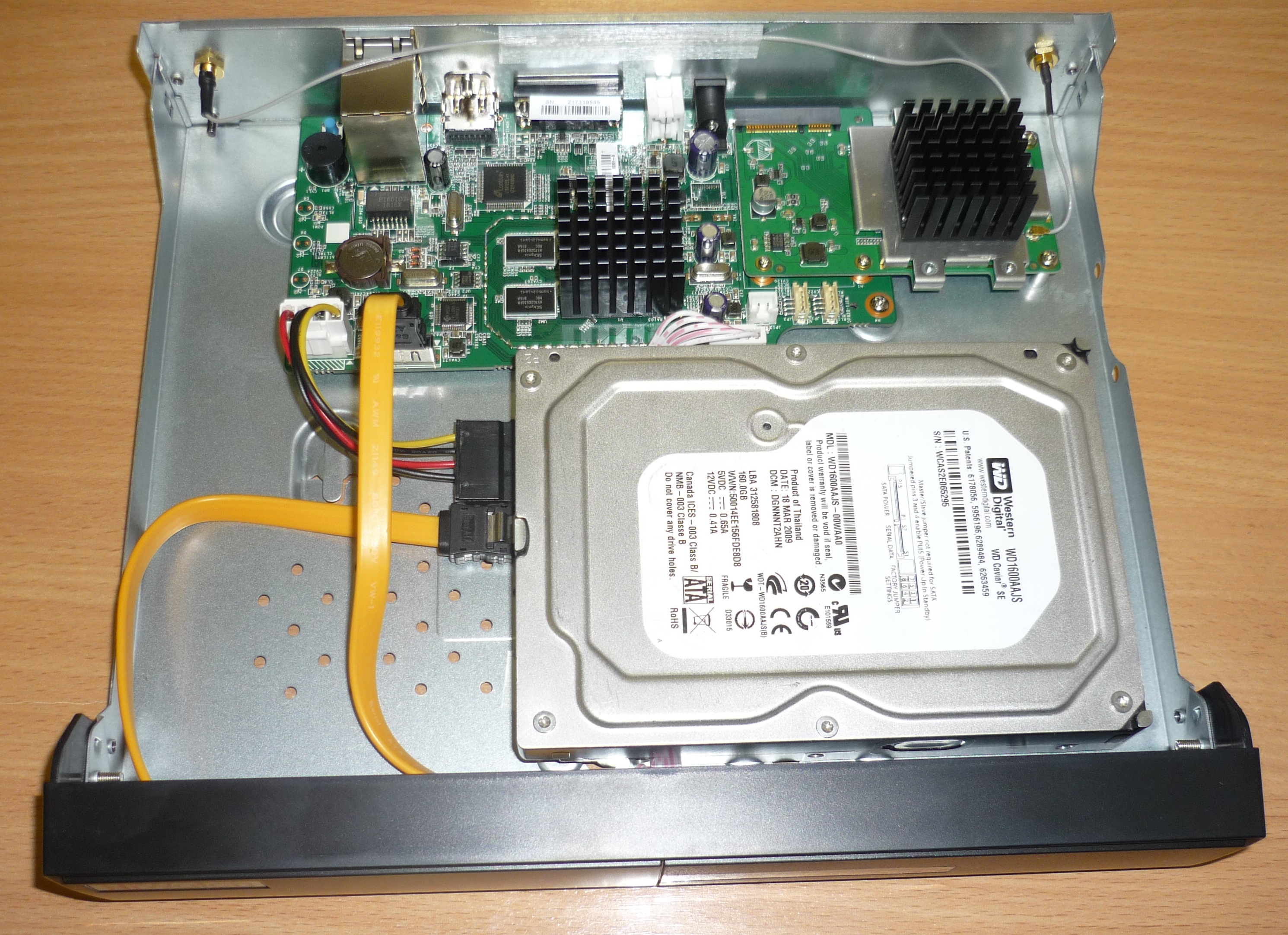
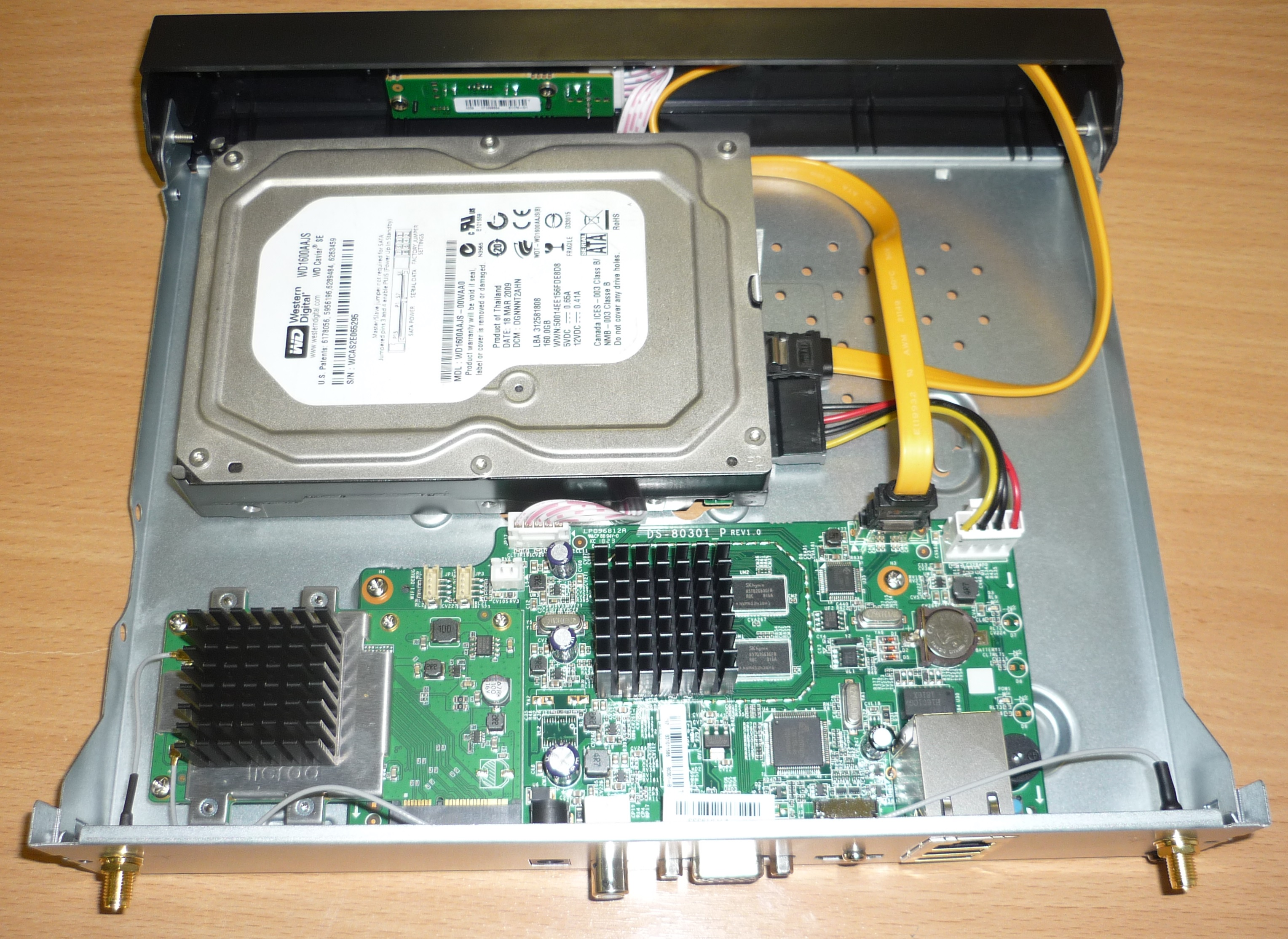
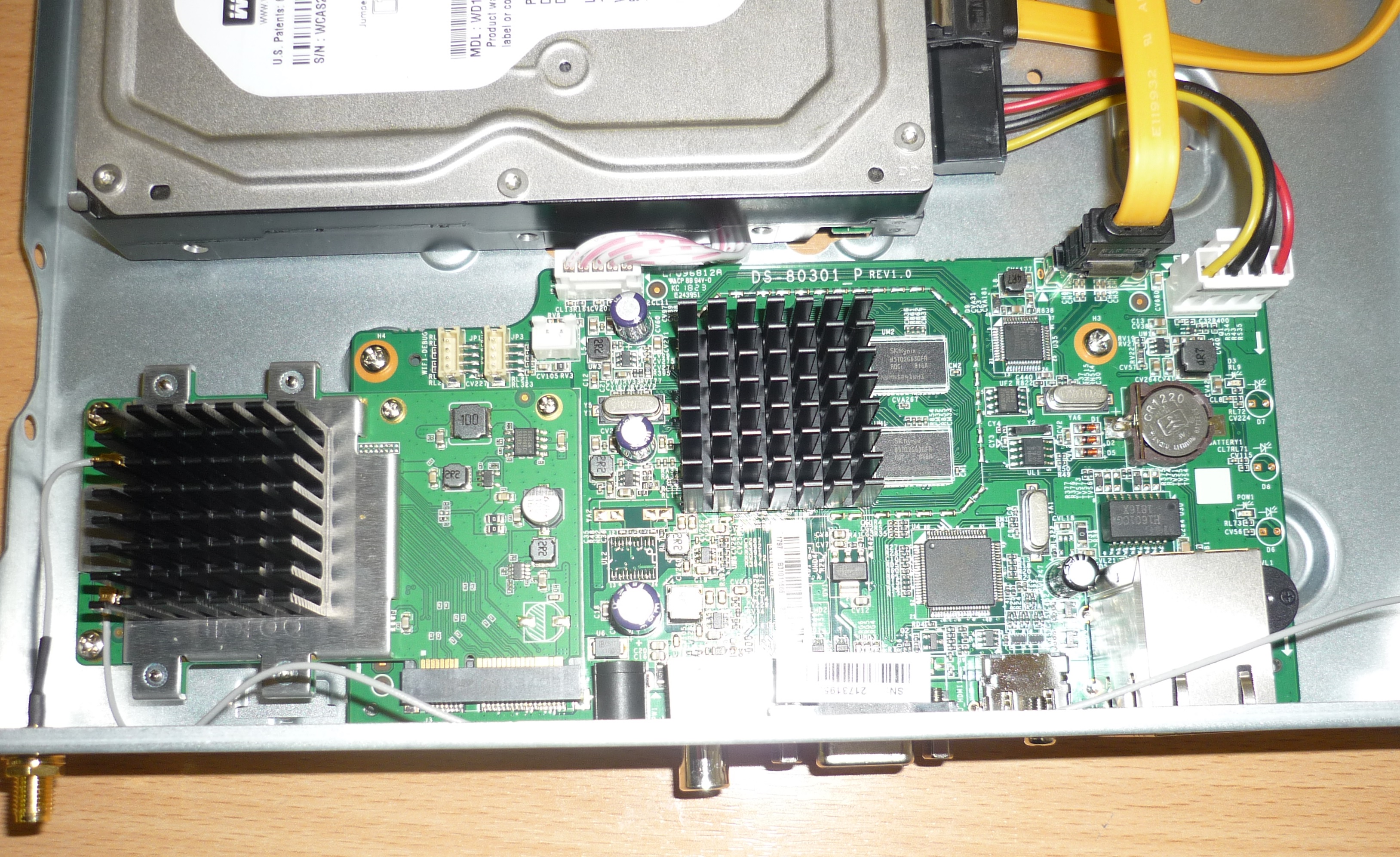
HDD 160GB was installed in this recorder, the recorder is running normally without HDD.

Power Supply:

Assembled device:

With monitor and camera data:
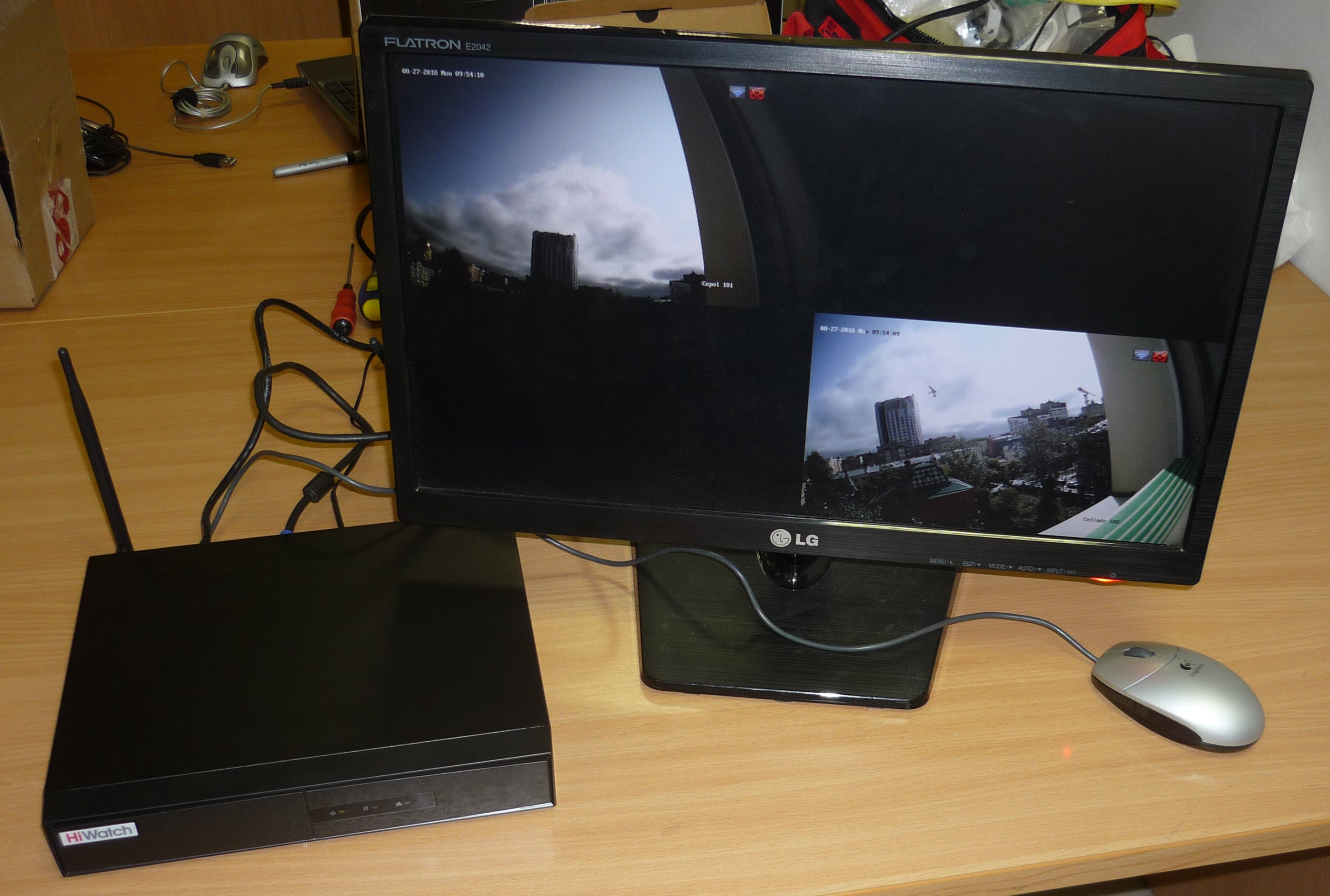
DS-I250W IP Camera:
IP Camera 1 - Description of Parameters
DS-I250W IP Camera:
Matrix: 1 / 2.8 Progressive scan CMOS.
Sensitivity: 0.025lk @ (F1.2, AGC on), 0.07lk @ (F2.0, AGC on).
Electronic shutter speed: 1/3 s ~ 1/100 000 s.
Lens: 2.8mm, 4mm, 6mm, 8mm @ F2.0, zoom lens.
Lens mount: M12.
Viewing angle: 114 ° (2.8mm), 90 ° (4mm), 54 ° (6mm), 43 ° (8mm).
Day / Night mode: Mechanical IR filter.
Adjusting the angle of installation: rotation: 0 ° - 360 °; tilt: -90 ° - 90 °; rotation: 0 ° - 360 °.
Compression
Video compression format: Main stream: H.265 / H.264. Additional stream: H.265 / H.264 / MJPEG.
H.264 profile: Baseline Profile / Main Profile / High Profile.
H.265 Profile: Main Profile.
Video bitrate: 32 kb / s ~ 8 Mbit / s.
Audio Compression: G.711 / G.722.1 / G.726 / MP2L2 / PCM.
Audio Bitrate: 64Kbit / s (G.711) / 16Kbit / s (G.722.1) / 16Kbit / s (G.726) / 32-160Kbit / s (MP2L2).
Picture
Maximum resolution: 1920 × 1080.
The main stream: 25 fps @ (1920 × 1080, 1280x960, 1280 × 720).
Additional stream: 25 fps @ (704x576, 640 × 480, 352 × 288, 320 × 240).
Image settings: Saturation, brightness, contrast, sharpness, mirroring and privacy mask are configured through the client software or a web browser.
Image enhancement: DWDR, 3D DNR, BLC, ROI (1 zone per stream).
Day / Night switch: Auto / scheduled.
Network
Network storage: NAS.
Protocols: TCP / IP, ICMP, HTTP, HTTPS, FTP, DHCP, DNS, DDNS, RTP, RTSP, RTCP, PPPoE, NTP, UPnP, SMTP, SNMP, IGMP, 802.1X, QoS, IPv6, UDP, Bonjour
Security: User authentication, watermarking, IP address filtering.
Compatibility: ONVIF (PROFILE S, PROFILE G), PSIA, CGI, ISAPI.
Triggering an alarm: Detecting unauthorized actions, breaking a network, IP address conflict.
Alarm actions: Notification to client software, sending email, uploading to FTP, activating a recording channel.
Interface
Network interface: 1 RJ45 10M / 100M Ethernet.
Audio input output: built-in microphone.
Environmental noise filtering: supported.
Sampling rate: 48kHz.
Reset button: Yes.
Wi-Fi
Wi-Fi standard IEEE802.11b / g / n.
Frequency range: 2.4 GHz ~ 2.472 GHz.
Channel width: 20 / 40MHz.
Protocols: 802.11b: CCK, QPSK, BPSK.
802.11g / n: OFDM.
Security: 64/128-bit WEP, WPA / WPA2, WPA-PSK / WPA2-PSK, WPS.
Transmitter power:
11b: 17 ± 1.5dBm @ 11 Mbps, 11g: 14 ± 1.5dBm @ 54 Mbps, 11n: 12.5 ± 1.5dBm.
Receiver sensitivity
11b: -90dBm @ 11 Mbps (Typical), 11g: -75dBm @ 54 Mbps (Typical), 11n: -74dBm (Typical).
Data transfer rate: 11b: 11 Mbps, 11g: 54 Mbps, 11n: 150 Mbps.
Reception radius: up to 150 m (depending on environmental conditions).
Main
Power supply: DC12V ± 25%.
Power consumption: 5W max.
Operating conditions: -30 ° - 60 ° , humidity 95% or less (without condensate).
Protection: IP66.
Body Material: Metal / Plastic.
The range of IR illumination: up to 30 m.
Dimensions: Ø76 mm x 150.1 mm.
Weight: 0.37 kg.
Matrix: 1 / 2.8 Progressive scan CMOS.
Sensitivity: 0.025lk @ (F1.2, AGC on), 0.07lk @ (F2.0, AGC on).
Electronic shutter speed: 1/3 s ~ 1/100 000 s.
Lens: 2.8mm, 4mm, 6mm, 8mm @ F2.0, zoom lens.
Lens mount: M12.
Viewing angle: 114 ° (2.8mm), 90 ° (4mm), 54 ° (6mm), 43 ° (8mm).
Day / Night mode: Mechanical IR filter.
Adjusting the angle of installation: rotation: 0 ° - 360 °; tilt: -90 ° - 90 °; rotation: 0 ° - 360 °.
Compression
Video compression format: Main stream: H.265 / H.264. Additional stream: H.265 / H.264 / MJPEG.
H.264 profile: Baseline Profile / Main Profile / High Profile.
H.265 Profile: Main Profile.
Video bitrate: 32 kb / s ~ 8 Mbit / s.
Audio Compression: G.711 / G.722.1 / G.726 / MP2L2 / PCM.
Audio Bitrate: 64Kbit / s (G.711) / 16Kbit / s (G.722.1) / 16Kbit / s (G.726) / 32-160Kbit / s (MP2L2).
Picture
Maximum resolution: 1920 × 1080.
The main stream: 25 fps @ (1920 × 1080, 1280x960, 1280 × 720).
Additional stream: 25 fps @ (704x576, 640 × 480, 352 × 288, 320 × 240).
Image settings: Saturation, brightness, contrast, sharpness, mirroring and privacy mask are configured through the client software or a web browser.
Image enhancement: DWDR, 3D DNR, BLC, ROI (1 zone per stream).
Day / Night switch: Auto / scheduled.
Network
Network storage: NAS.
Protocols: TCP / IP, ICMP, HTTP, HTTPS, FTP, DHCP, DNS, DDNS, RTP, RTSP, RTCP, PPPoE, NTP, UPnP, SMTP, SNMP, IGMP, 802.1X, QoS, IPv6, UDP, Bonjour
Security: User authentication, watermarking, IP address filtering.
Compatibility: ONVIF (PROFILE S, PROFILE G), PSIA, CGI, ISAPI.
Triggering an alarm: Detecting unauthorized actions, breaking a network, IP address conflict.
Alarm actions: Notification to client software, sending email, uploading to FTP, activating a recording channel.
Interface
Network interface: 1 RJ45 10M / 100M Ethernet.
Audio input output: built-in microphone.
Environmental noise filtering: supported.
Sampling rate: 48kHz.
Reset button: Yes.
Wi-Fi
Wi-Fi standard IEEE802.11b / g / n.
Frequency range: 2.4 GHz ~ 2.472 GHz.
Channel width: 20 / 40MHz.
Protocols: 802.11b: CCK, QPSK, BPSK.
802.11g / n: OFDM.
Security: 64/128-bit WEP, WPA / WPA2, WPA-PSK / WPA2-PSK, WPS.
Transmitter power:
11b: 17 ± 1.5dBm @ 11 Mbps, 11g: 14 ± 1.5dBm @ 54 Mbps, 11n: 12.5 ± 1.5dBm.
Receiver sensitivity
11b: -90dBm @ 11 Mbps (Typical), 11g: -75dBm @ 54 Mbps (Typical), 11n: -74dBm (Typical).
Data transfer rate: 11b: 11 Mbps, 11g: 54 Mbps, 11n: 150 Mbps.
Reception radius: up to 150 m (depending on environmental conditions).
Main
Power supply: DC12V ± 25%.
Power consumption: 5W max.
Operating conditions: -30 ° - 60 ° , humidity 95% or less (without condensate).
Protection: IP66.
Body Material: Metal / Plastic.
The range of IR illumination: up to 30 m.
Dimensions: Ø76 mm x 150.1 mm.
Weight: 0.37 kg.
Photos out of the box:
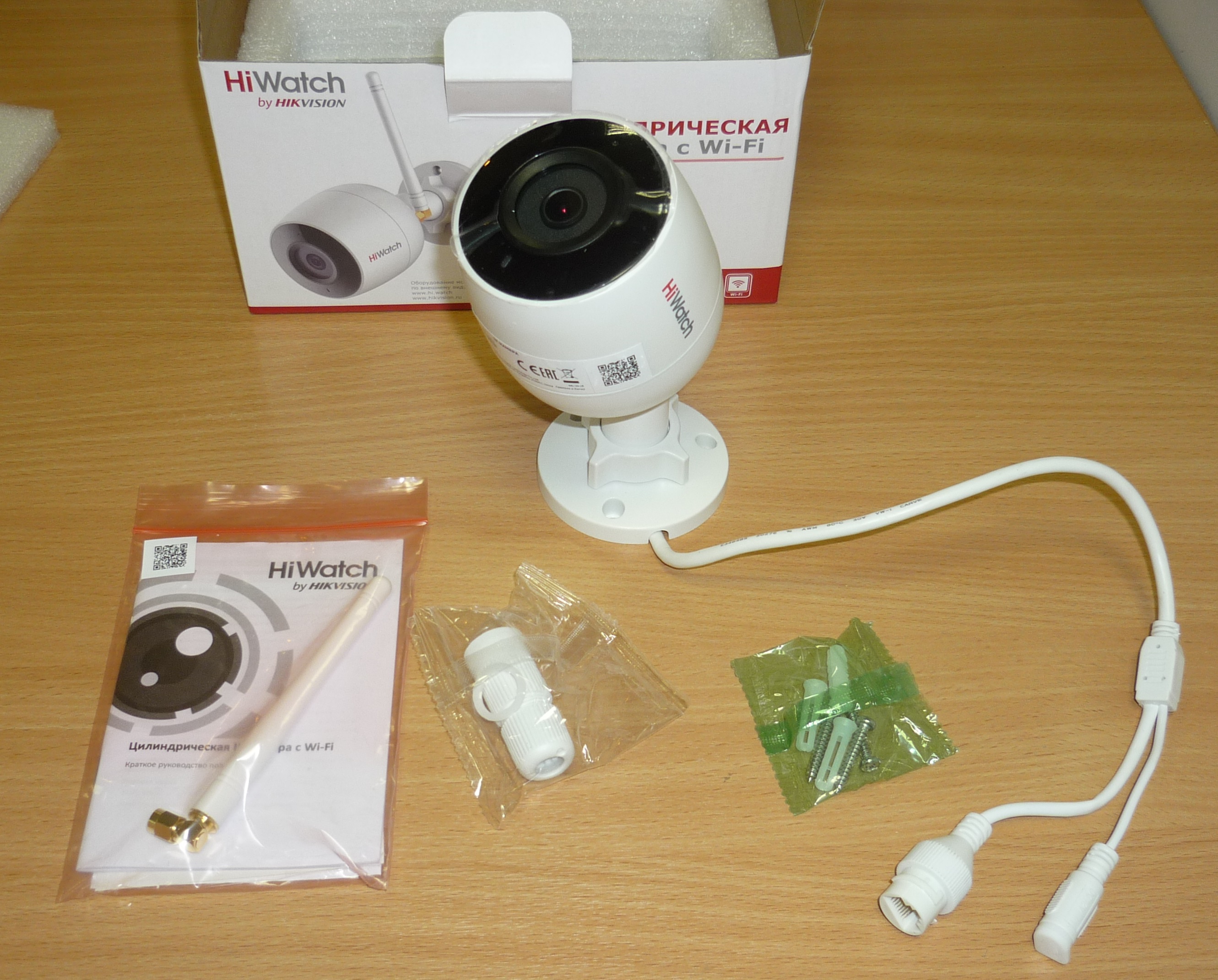
Back view:
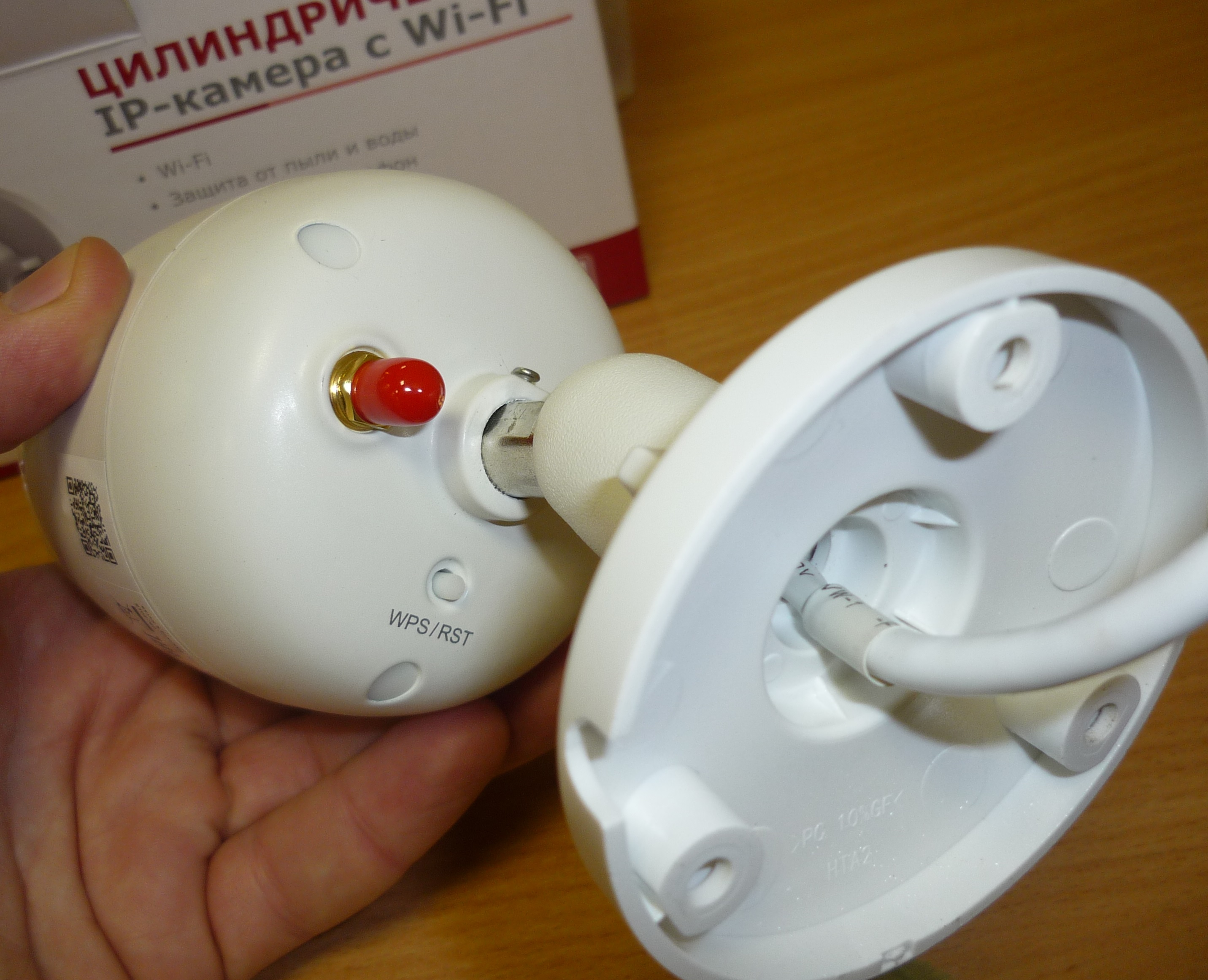
Included is no power supply, connect with a battery cable.
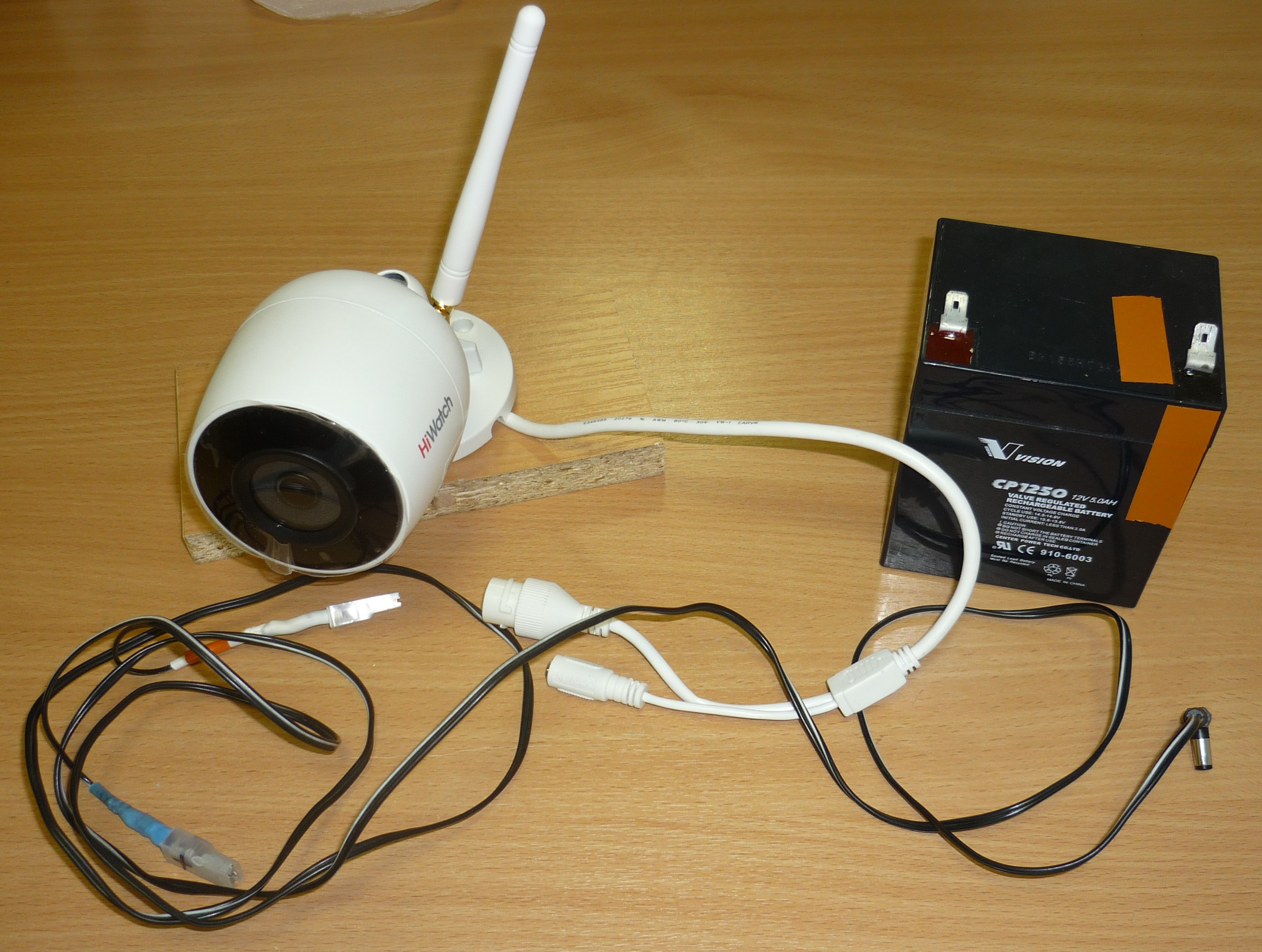
DS-I252W IP Camera:
IP camera 2 - description of parameters
DS-I252W IP Camera:
Matrix: 1 / 2.8 Progressive scan CMOS.
Sensitivity: 0.025lk @ (F1.2, AGC on), 0.07lk @ (F2.0, AGC on).
Electronic shutter speed: 1/3 s ~ 1/100 000 s.
Lens: 2.8mm, 4mm, 6mm, 8mm @ F2.0, zoom lens.
Lens mount: M12.
Viewing angle: 114 ° (2.8mm), 90 ° (4mm), 54 ° (6mm), 43 ° (8mm).
Day / Night mode: Mechanical IR filter.
Adjusting the angle of installation: rotation: 0 ° - 355 °; tilt: 0 ° - 75 °.
Compression
Video compression format: main stream: H.265 / H.264, additional stream: H.265 / H.264 / MJPEG.
H.264 profile: Baseline Profile / Main Profile / High Profile.
H.265 Profile: Main Profile.
Video bitrate: 32 kb / s ~ 8 Mbit / s.
Audio Compression: G.711 / G.722.1 / G.726 / MP2L2 / PCM.
Audio Bitrate: 64Kbit / s (G.711) / 16Kbit / s (G.722.1) / 16Kbit / s (G.726) / 32-160Kbit / s (MP2L2).
Picture
Maximum resolution: 1920 × 1080.
The main stream: 25 fps @ (1920 × 1080, 1280x960, 1280 × 720).
Additional stream: 25 fps @ (704x576, 640 × 480, 352 × 288, 320 × 240).
Image settings: Saturation, brightness, contrast, sharpness, mirroring and privacy mask are configured through the client software or a web browser.
Image enhancement: DWDR, 3D DNR, BLC, ROI (1 zone per stream).
Day / Night switch: Auto / scheduled.
Network
Protocols: TCP / IP, ICMP, HTTP, HTTPS, FTP, DHCP, DNS, DDNS, RTP, RTSP, RTCP, PPPoE, NTP, UPnP, SMTP, SNMP, IGMP, 802.1X, QoS, IPv6, UDP, Bonjour.
Security: User authentication, watermarking, IP address filtering.
Compatibility: ONVIF (PROFILE S, PROFILE G), PSIA, CGI, ISAPI.
Triggering an alarm: Detecting unauthorized actions, breaking a network, IP address conflict.
Alarm actions: Notification to client software, sending email, uploading to FTP, activating a recording channel.
Interface
Network interface: 1 RJ45 10M / 100M Ethernet.
Audio input output: built-in microphone.
Environmental noise filtering: supported.
Sampling rate: 48kHz.
Reset button: Yes.
Wi-Fi
Wi-Fi standard IEEE802.11b / g / n
Frequency range: 2.4 GHz ~ 2.472 GHz.
Channel width: 20 / 40MHz.
Protocols: 802.11b: CCK, QPSK, BPSK.
802.11g / n: OFDM.
Security: 64/128-bit WEP, WPA / WPA2, WPA-PSK / WPA2-PSK, WPS.
Transmitter power: 11b: 17 ± 1.5dBm @ 11Mbit / s, 11g: 14 ± 1.5dBm @ 54Mbit / s, 11n: 12.5 ± 1.5dBm.
Receiver sensitivity:
11b: -90dBm @ 11 Mbps (Typical), 11g: -75dBm @ 54 Mbps (Typical), 11n: -74dBm (Typical).
Data transfer rate: 11b: 11 Mbps, 11g: 54 Mbps, 11n: 150 Mbps.
Reception radius: up to 150 m (depending on environmental conditions).
Main
Power supply: DC12V ± 25%.
Power Consumption: 5 W max.
Operating conditions: -20 ° C - 45 ° C, humidity 95% or less (non-condensing).
Protection: IP66.
Body Material: Plastic.
Range of IR illumination: up to 30m.
Dimensions: Ø 121.36 mm x 92.21 mm.
Weight: 0.465 kg.
Matrix: 1 / 2.8 Progressive scan CMOS.
Sensitivity: 0.025lk @ (F1.2, AGC on), 0.07lk @ (F2.0, AGC on).
Electronic shutter speed: 1/3 s ~ 1/100 000 s.
Lens: 2.8mm, 4mm, 6mm, 8mm @ F2.0, zoom lens.
Lens mount: M12.
Viewing angle: 114 ° (2.8mm), 90 ° (4mm), 54 ° (6mm), 43 ° (8mm).
Day / Night mode: Mechanical IR filter.
Adjusting the angle of installation: rotation: 0 ° - 355 °; tilt: 0 ° - 75 °.
Compression
Video compression format: main stream: H.265 / H.264, additional stream: H.265 / H.264 / MJPEG.
H.264 profile: Baseline Profile / Main Profile / High Profile.
H.265 Profile: Main Profile.
Video bitrate: 32 kb / s ~ 8 Mbit / s.
Audio Compression: G.711 / G.722.1 / G.726 / MP2L2 / PCM.
Audio Bitrate: 64Kbit / s (G.711) / 16Kbit / s (G.722.1) / 16Kbit / s (G.726) / 32-160Kbit / s (MP2L2).
Picture
Maximum resolution: 1920 × 1080.
The main stream: 25 fps @ (1920 × 1080, 1280x960, 1280 × 720).
Additional stream: 25 fps @ (704x576, 640 × 480, 352 × 288, 320 × 240).
Image settings: Saturation, brightness, contrast, sharpness, mirroring and privacy mask are configured through the client software or a web browser.
Image enhancement: DWDR, 3D DNR, BLC, ROI (1 zone per stream).
Day / Night switch: Auto / scheduled.
Network
Protocols: TCP / IP, ICMP, HTTP, HTTPS, FTP, DHCP, DNS, DDNS, RTP, RTSP, RTCP, PPPoE, NTP, UPnP, SMTP, SNMP, IGMP, 802.1X, QoS, IPv6, UDP, Bonjour.
Security: User authentication, watermarking, IP address filtering.
Compatibility: ONVIF (PROFILE S, PROFILE G), PSIA, CGI, ISAPI.
Triggering an alarm: Detecting unauthorized actions, breaking a network, IP address conflict.
Alarm actions: Notification to client software, sending email, uploading to FTP, activating a recording channel.
Interface
Network interface: 1 RJ45 10M / 100M Ethernet.
Audio input output: built-in microphone.
Environmental noise filtering: supported.
Sampling rate: 48kHz.
Reset button: Yes.
Wi-Fi
Wi-Fi standard IEEE802.11b / g / n
Frequency range: 2.4 GHz ~ 2.472 GHz.
Channel width: 20 / 40MHz.
Protocols: 802.11b: CCK, QPSK, BPSK.
802.11g / n: OFDM.
Security: 64/128-bit WEP, WPA / WPA2, WPA-PSK / WPA2-PSK, WPS.
Transmitter power: 11b: 17 ± 1.5dBm @ 11Mbit / s, 11g: 14 ± 1.5dBm @ 54Mbit / s, 11n: 12.5 ± 1.5dBm.
Receiver sensitivity:
11b: -90dBm @ 11 Mbps (Typical), 11g: -75dBm @ 54 Mbps (Typical), 11n: -74dBm (Typical).
Data transfer rate: 11b: 11 Mbps, 11g: 54 Mbps, 11n: 150 Mbps.
Reception radius: up to 150 m (depending on environmental conditions).
Main
Power supply: DC12V ± 25%.
Power Consumption: 5 W max.
Operating conditions: -20 ° C - 45 ° C, humidity 95% or less (non-condensing).
Protection: IP66.
Body Material: Plastic.
Range of IR illumination: up to 30m.
Dimensions: Ø 121.36 mm x 92.21 mm.
Weight: 0.465 kg.
Photos out of the box:
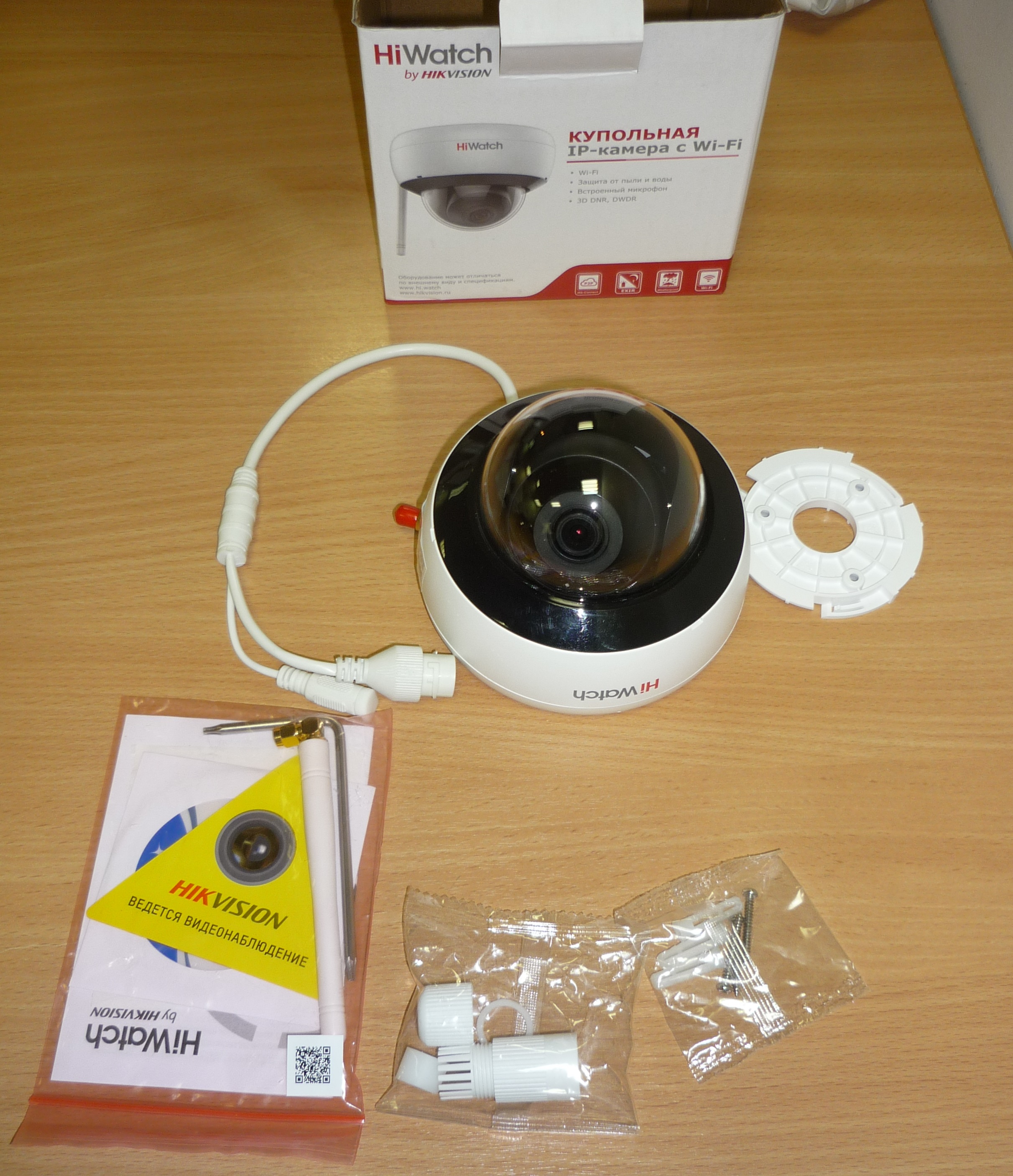
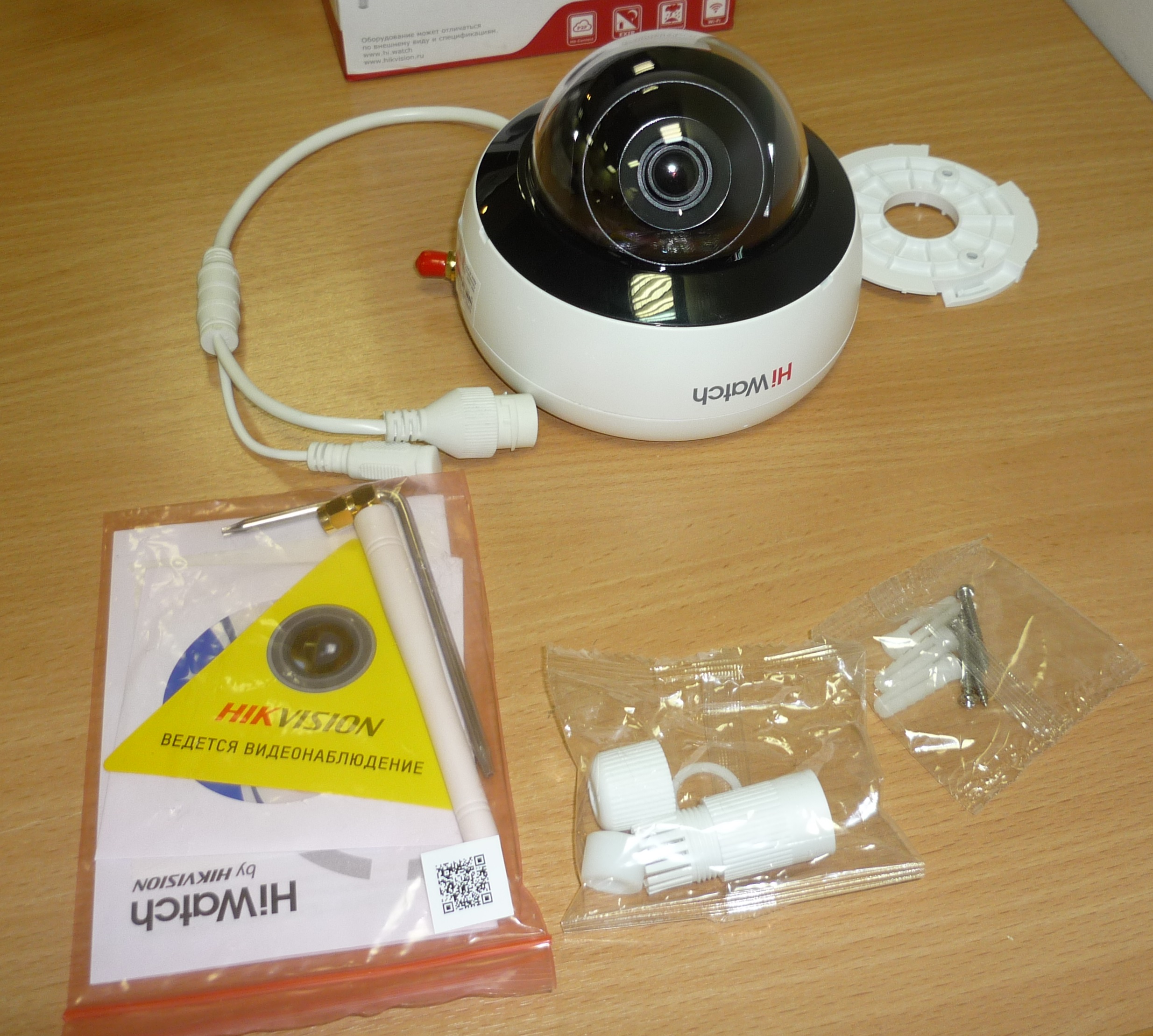
Back view:
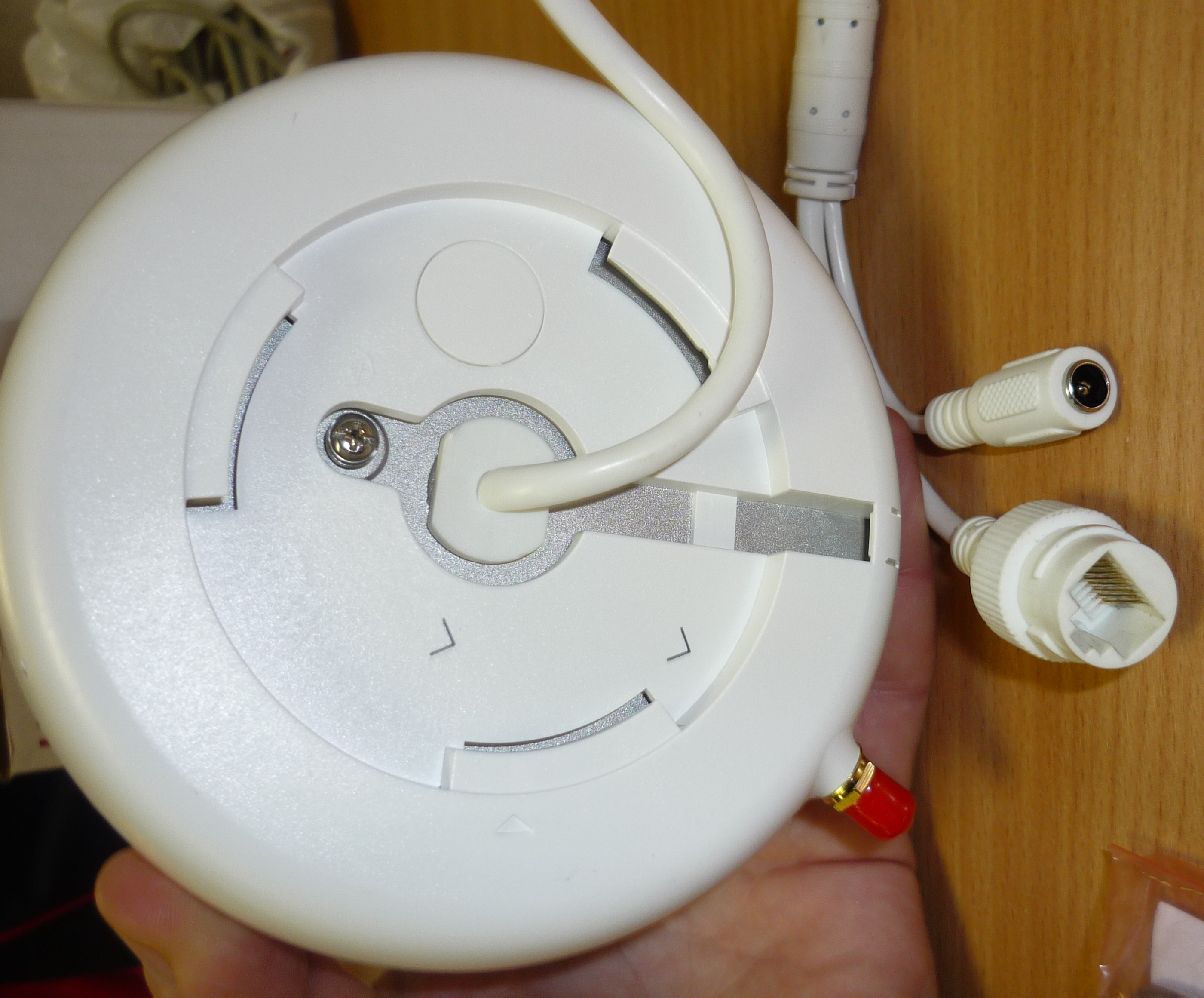
With battery:

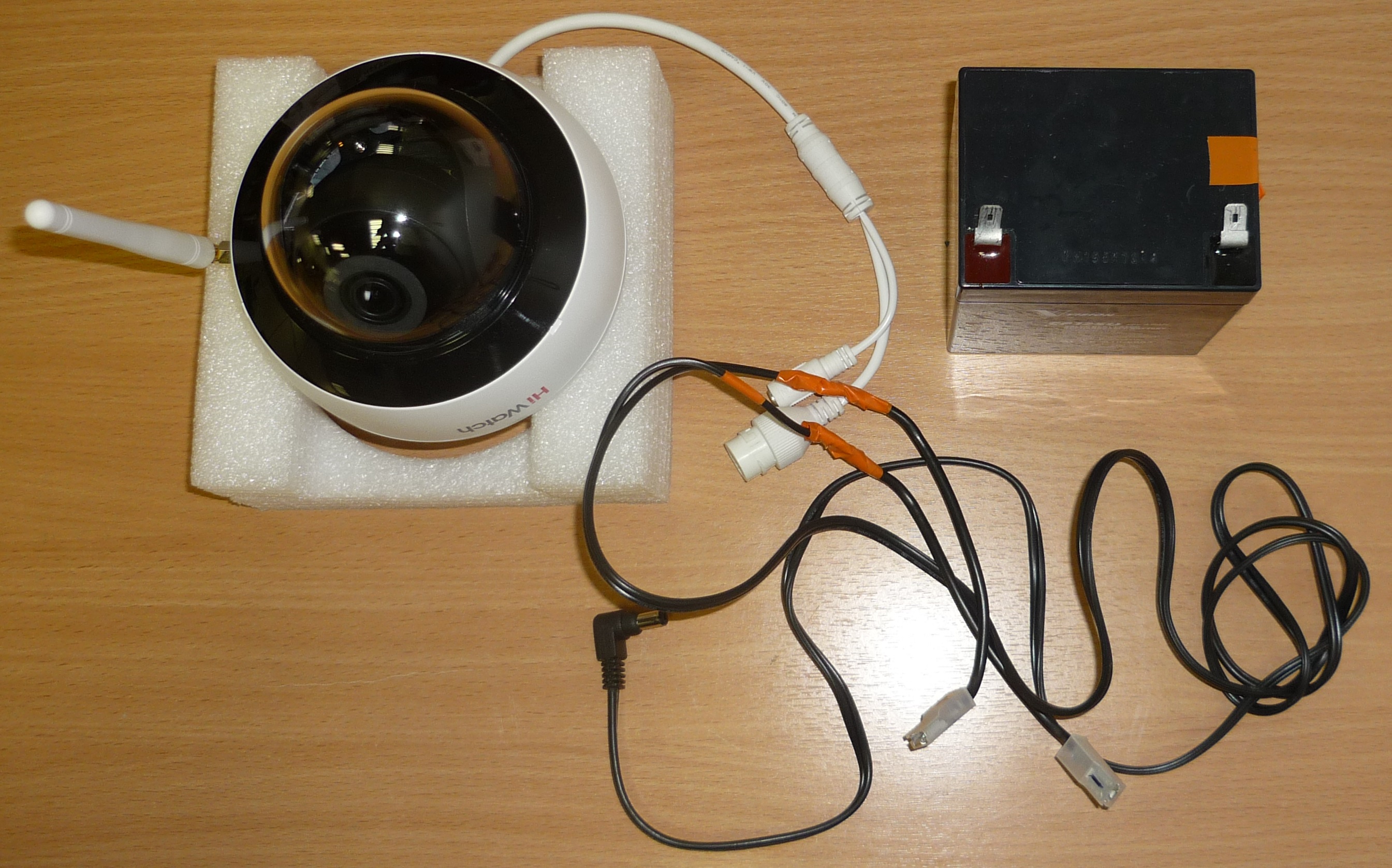
Setup and connection of equipment:
In principle, everything is quite simple. But there are nuances.
IP-DVR is configured using a directly connected monitor and USB mouse.
Set the pattern key is required:
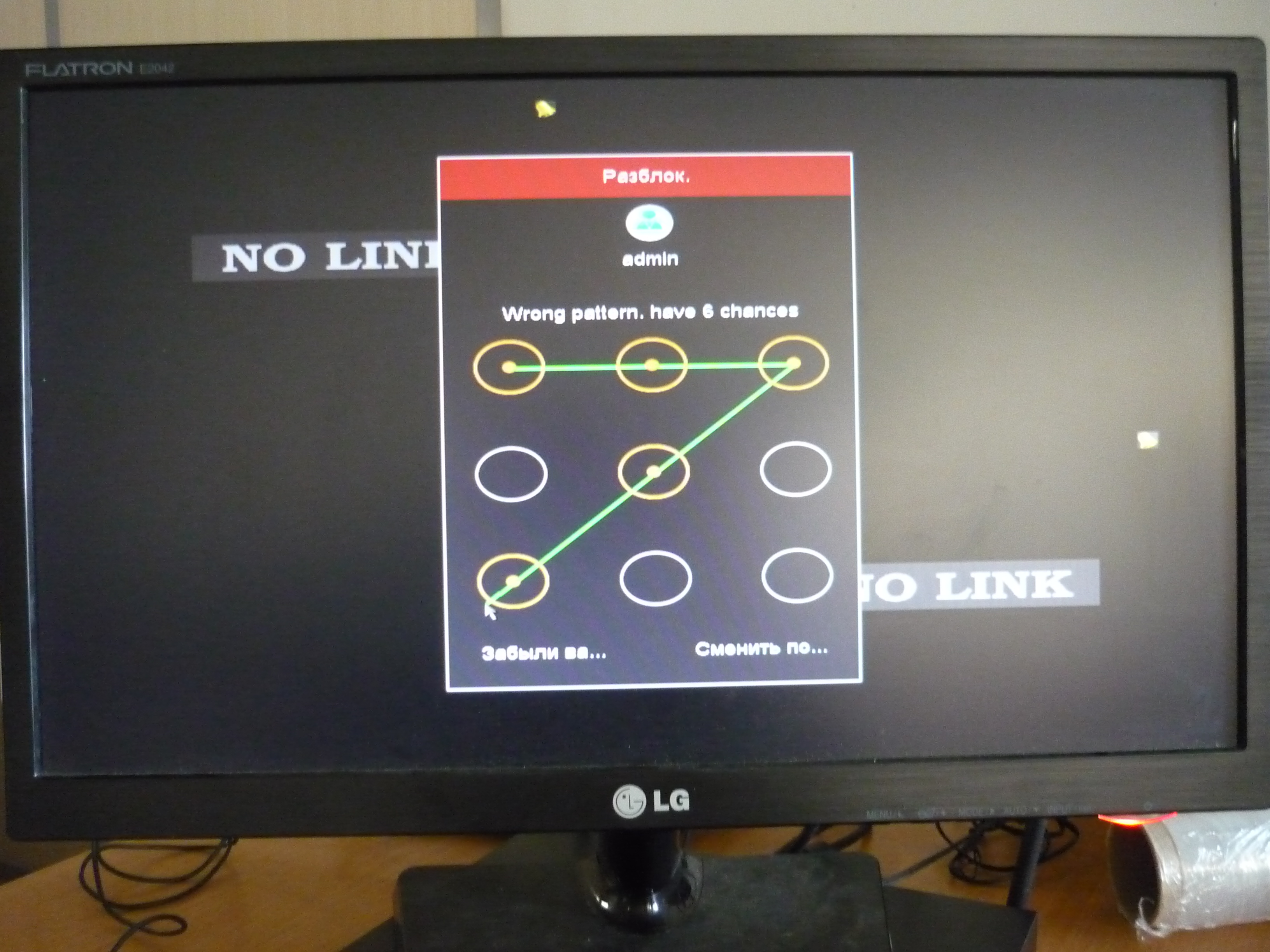
General settings:
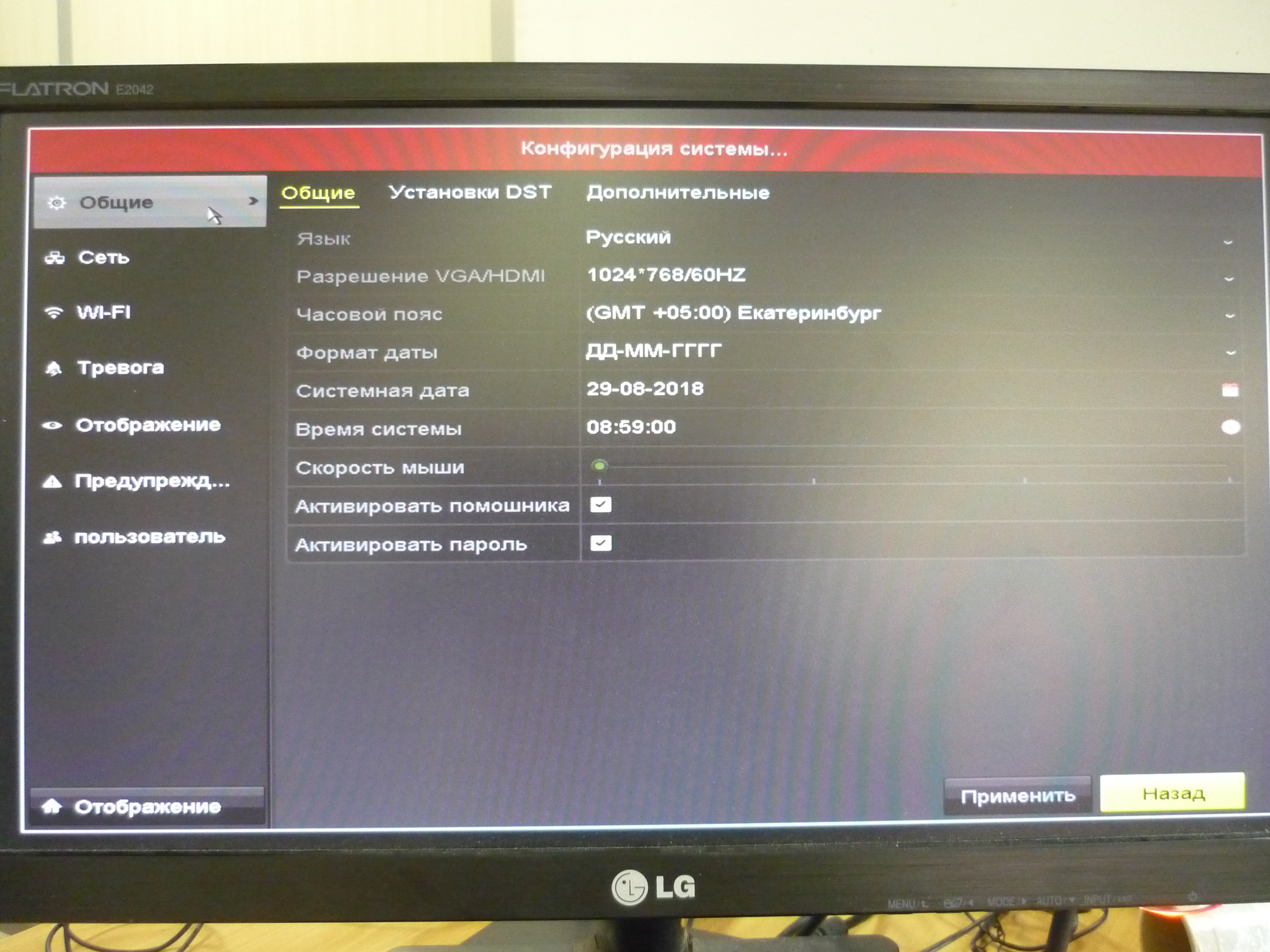
Network wired settings:
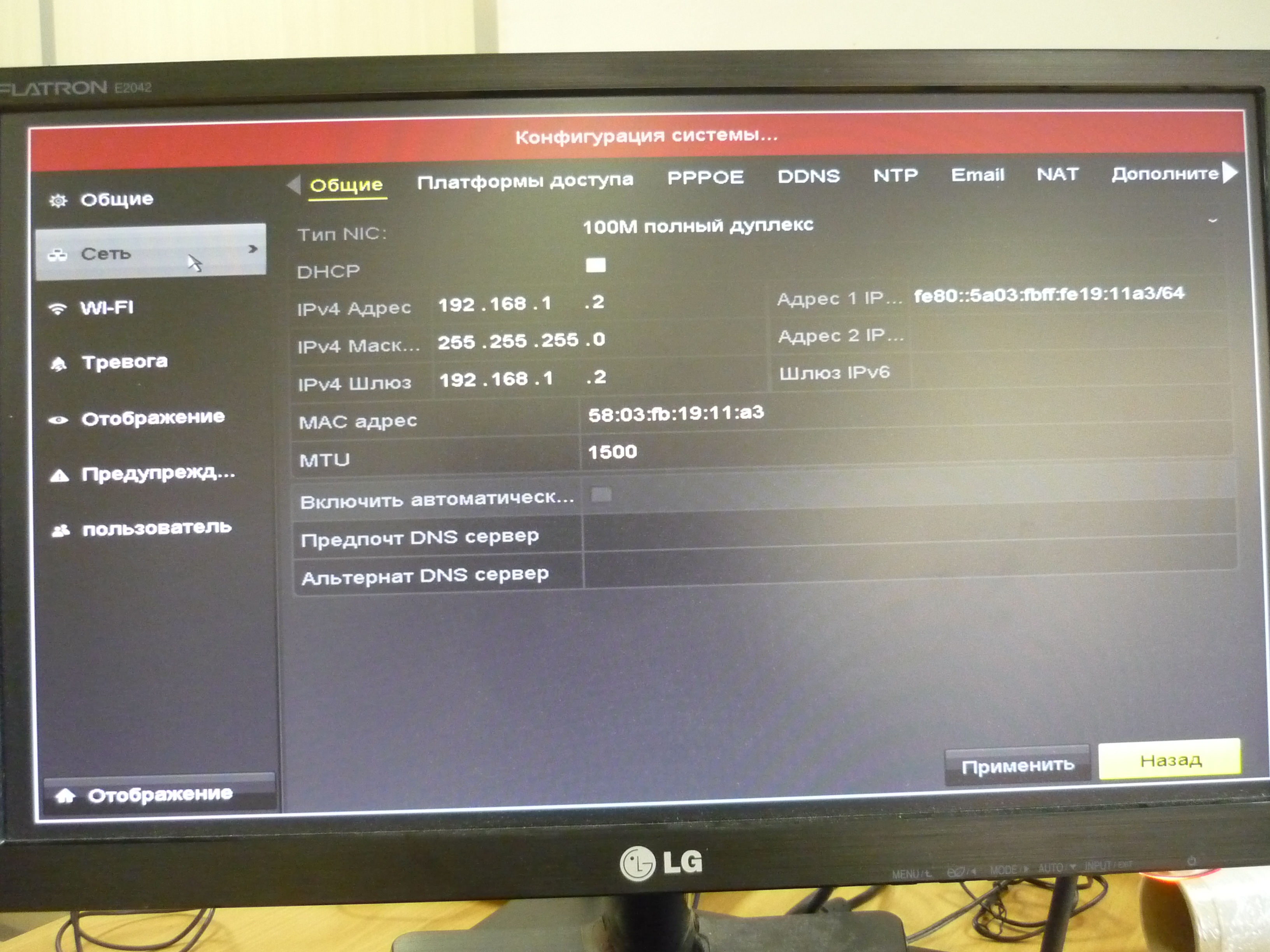
Wireless network settings:

Now we can access via the web interface via a wired connection:

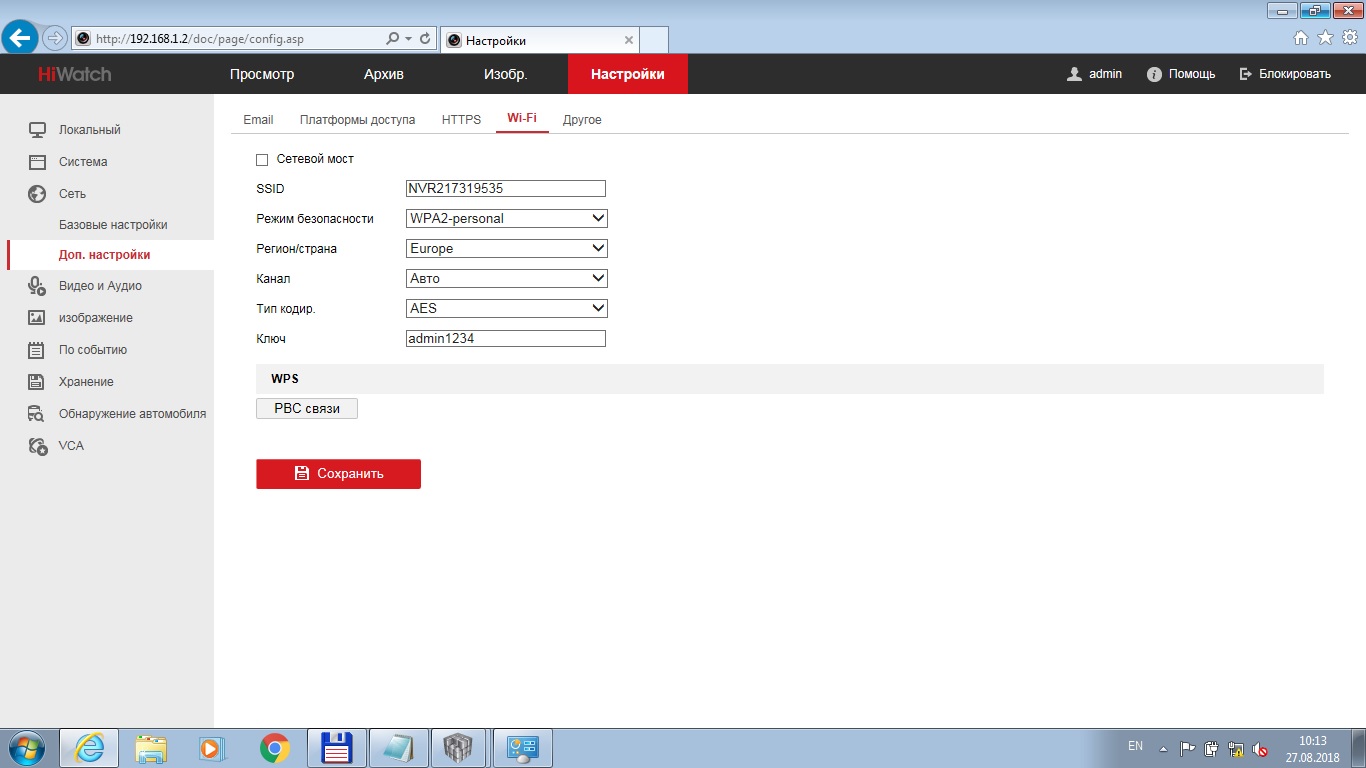
Wi-Fi networks in the area:
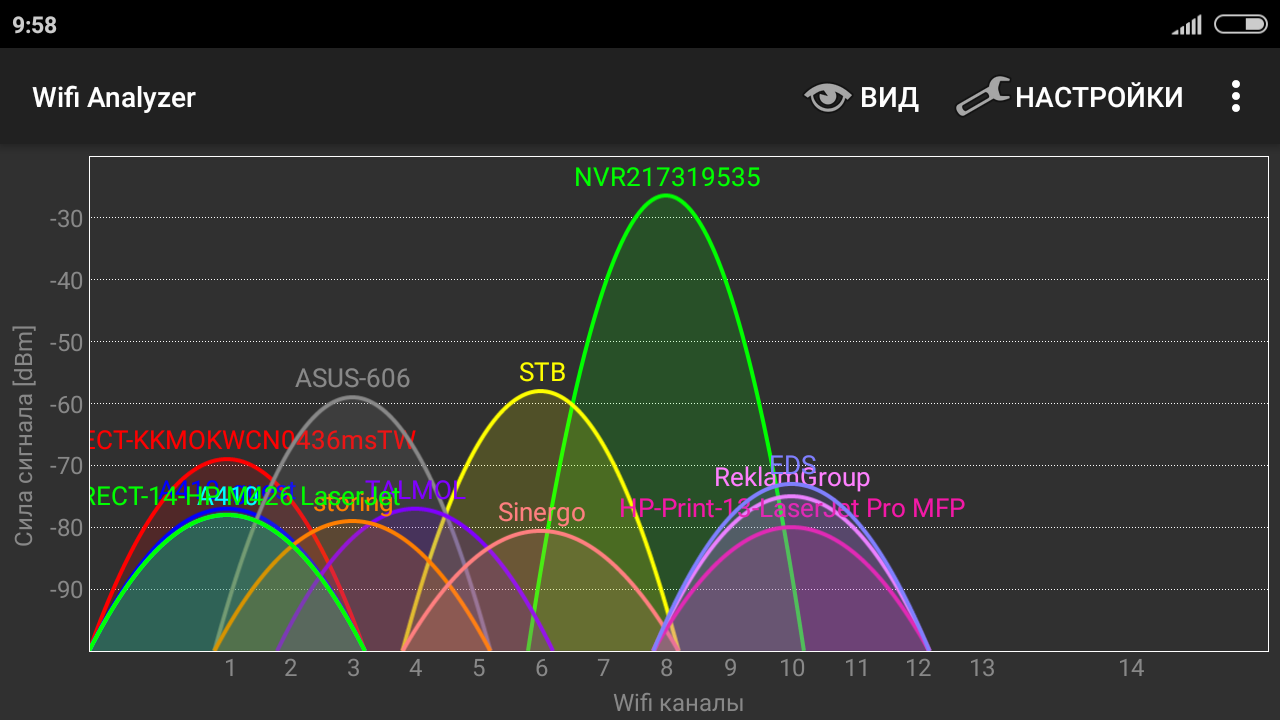
Now we connect to the IP video recorder via Wi-Fi:
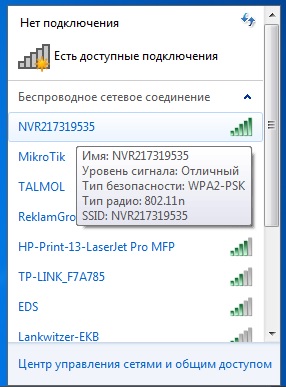

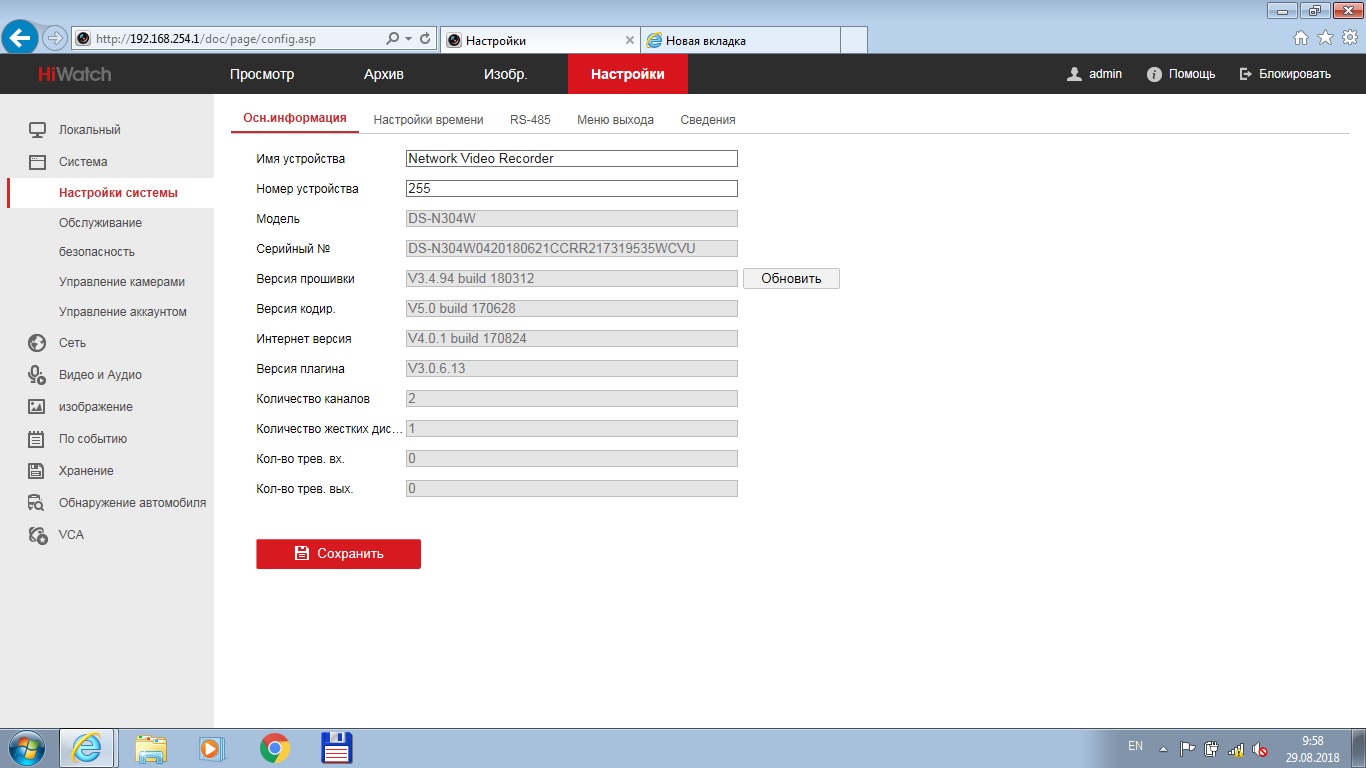
Cameras inactive:

One camera connected:
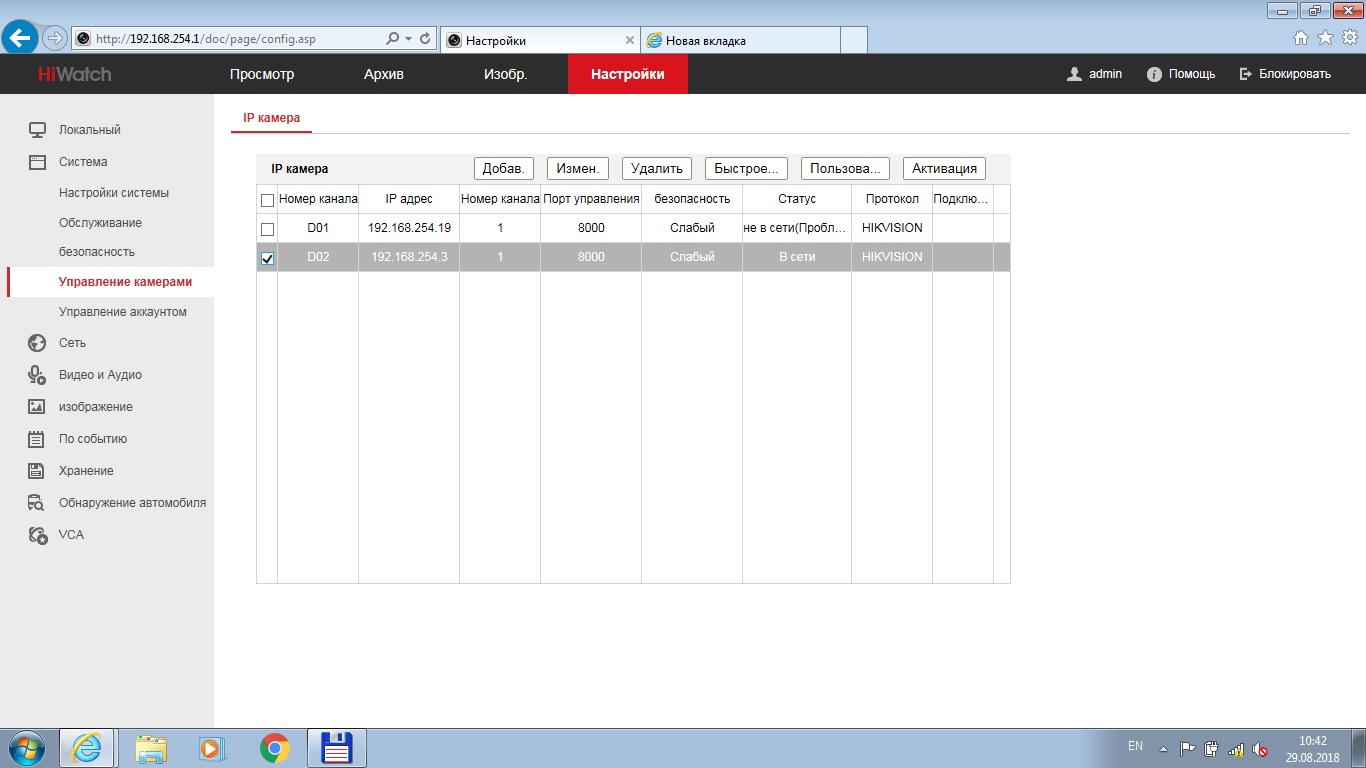
What can be seen on the monitor from the recorder:
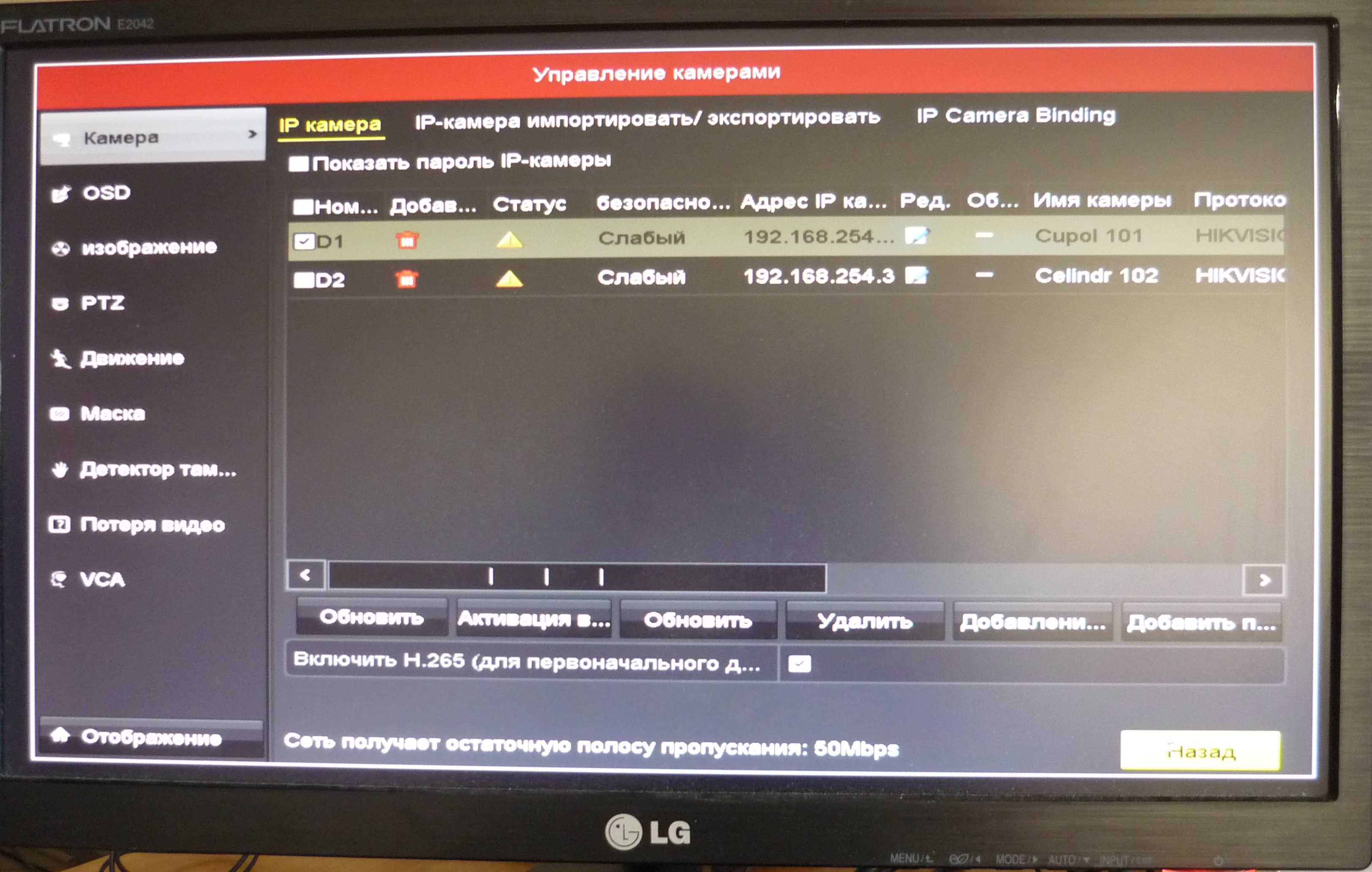
Rename camera names:

Initial configuration of IP cameras is also best carried out in wired mode. We expose login \ password, we configure network parameters for wire connection. There we are already entering the web interface and are connecting to the wireless network.
Problem - How to view the device in the browser .
Internet Explorer is our everything ... Here is the future.
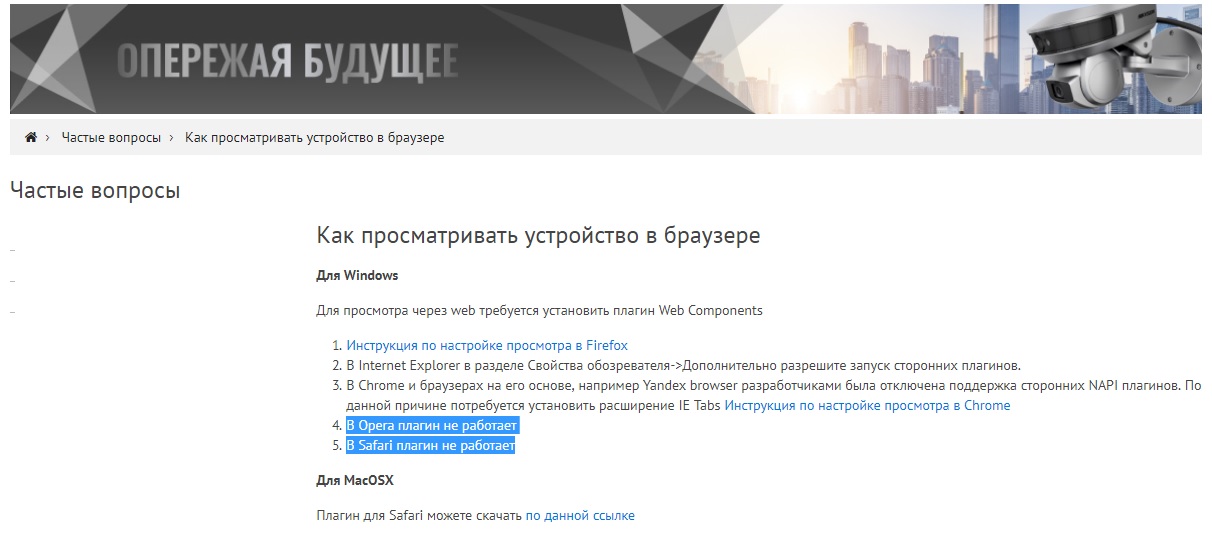
We allow the use of a third-party plug-in and connects the video stream:
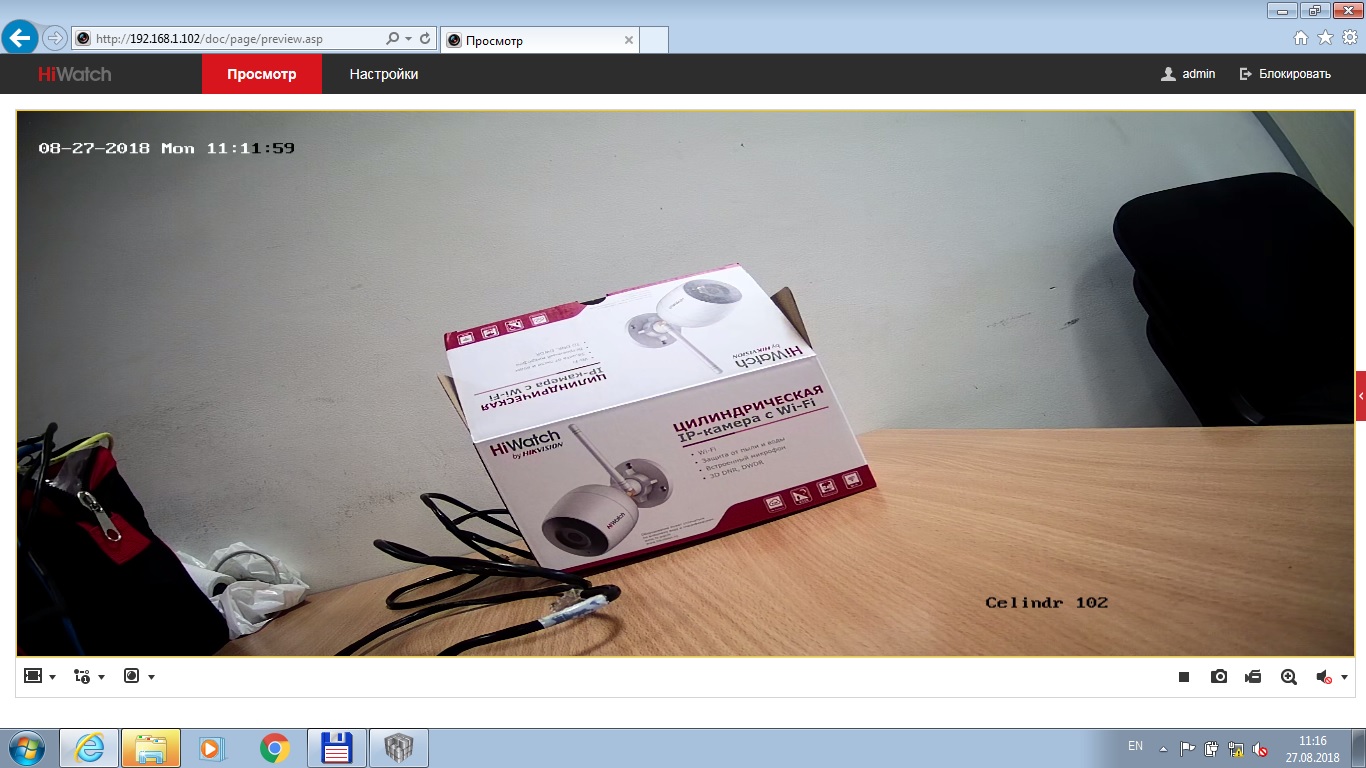
We turn ONVIF on and start a user there (it will be necessary later for the video server software)

We connect, but already through Wi-Fi:
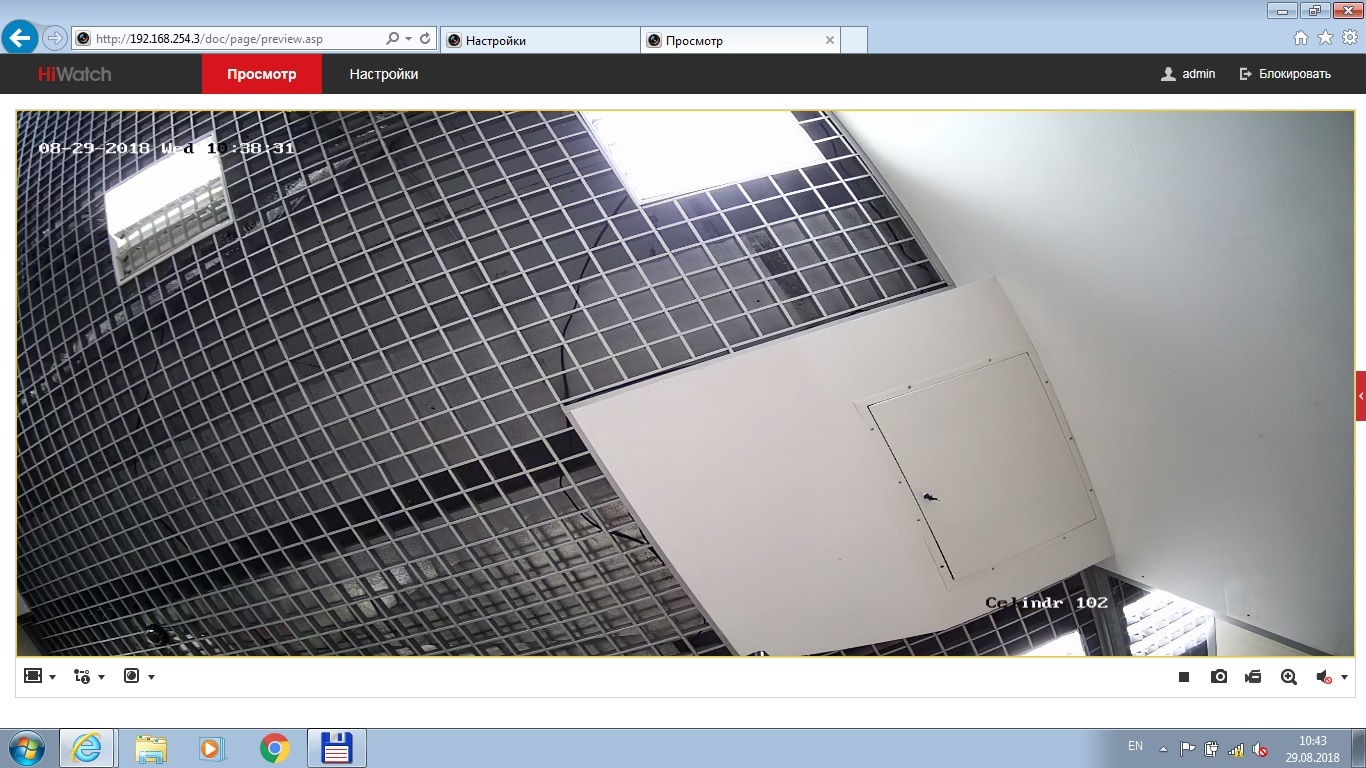
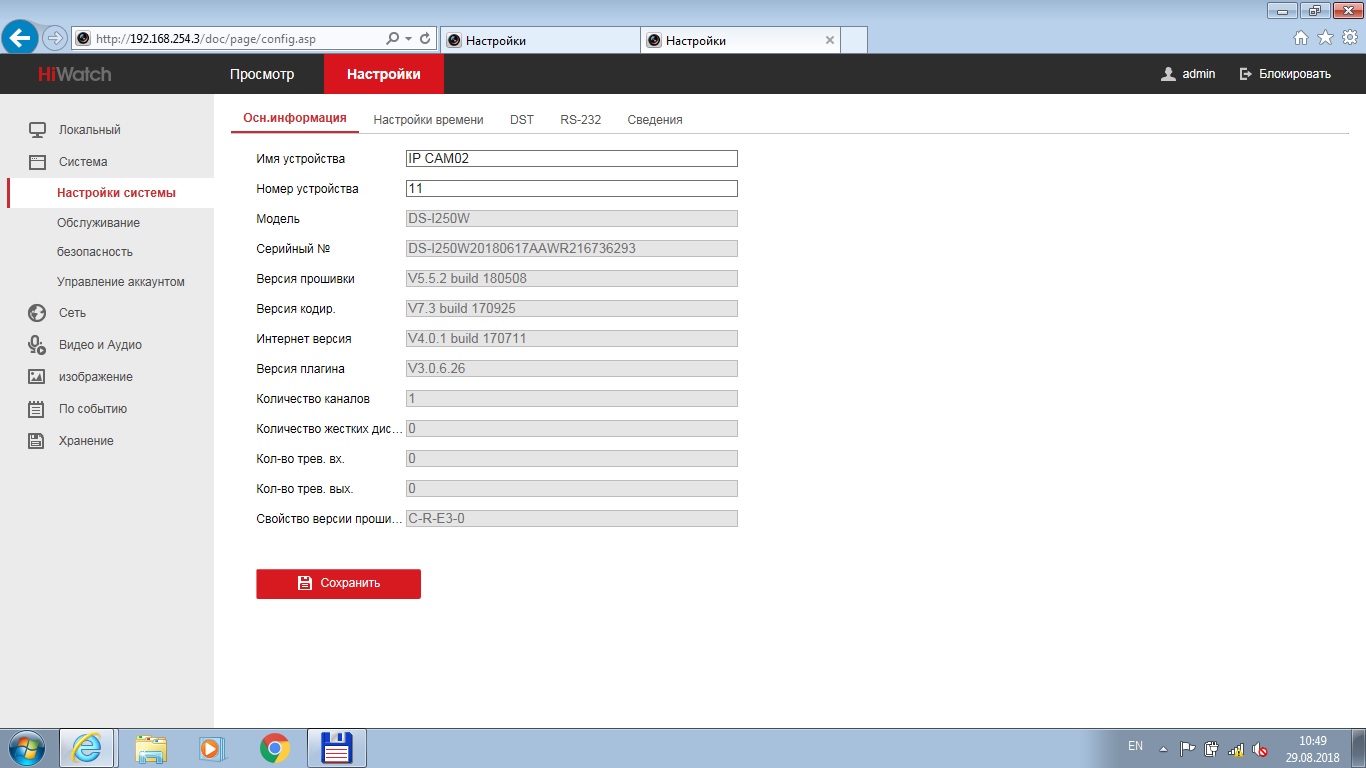

The logic of the work and the design of the video stream archive are as follows:
- DVR records data on Wi-Fi in maximum quality (video + audio) from each camera to HDD all the time (in viewing mode you will see where the movement was the same and not just static);
- The video server receives camera streams from the DVR using the RTSP protocol and records data with a long storage time + processes the video stream — analyzes it using certain algorithms (is there a helmet on the person, smoke and fire detection, etc.).
After communicating with those. support received data:
Registrar: if the registrar you specify can send streams of cameras connected to it via the RTSP protocol, you can connect these streams to VideoNet via the Universal RTSP protocol as separate ip cameras. To connect these streams, you need full RTSP URLs for each plugin.
VideoNet could receive sound, it is necessary that this sound be in the RTSP stream requested from the recorder. It is possible that for this you need to somehow further configure the recorder, you may need to use other RTSP URLs (in which there will be an indication of streams with sound). It makes sense to clarify the situation with the registrar manufacturer.
In our case, these are streams:
rtsp: // admin: admin1234@192.168.1.2: 554 / Streaming / Channels / 101
rtsp: // admin: admin1234@192.168.1.2: 554 / Streaming / Channels / 201
We connect the DVR to the video server:
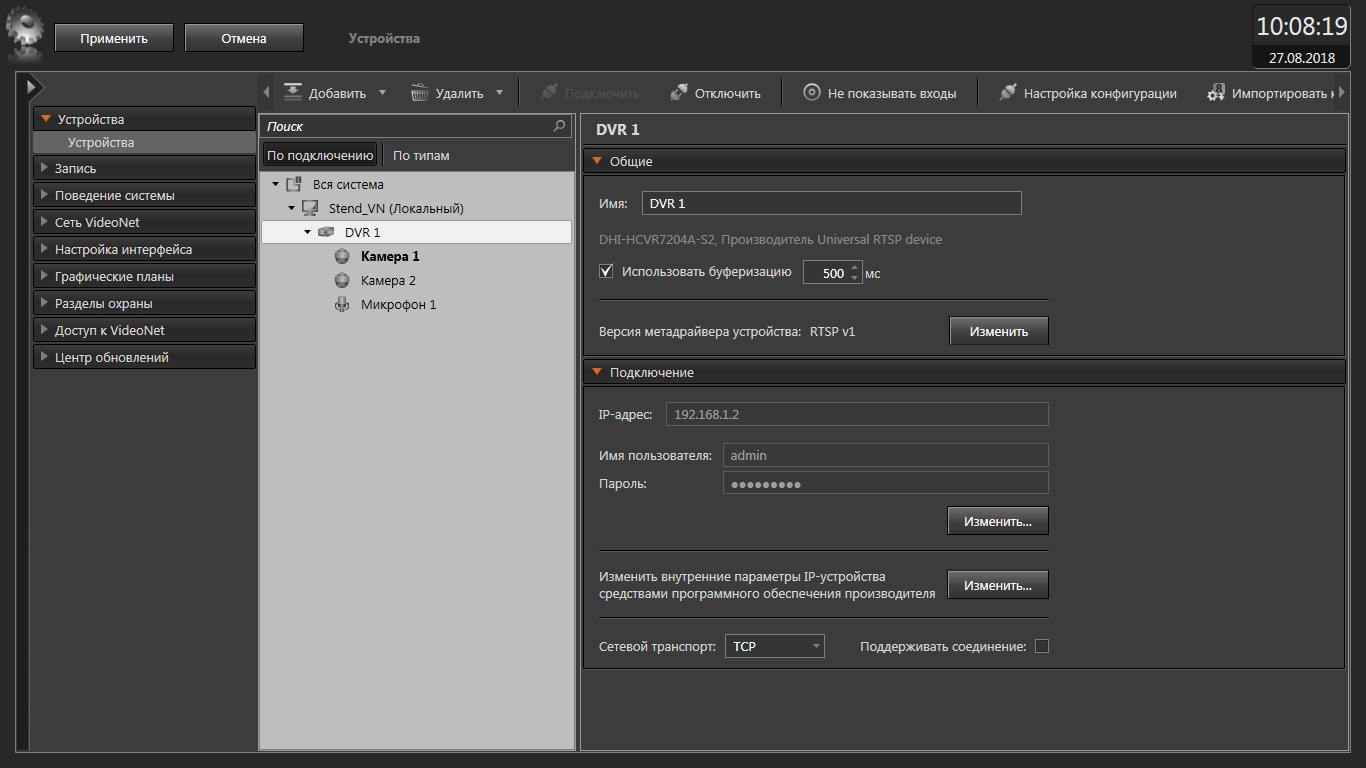
Configure the parameters of ip-cameras:

The event log:
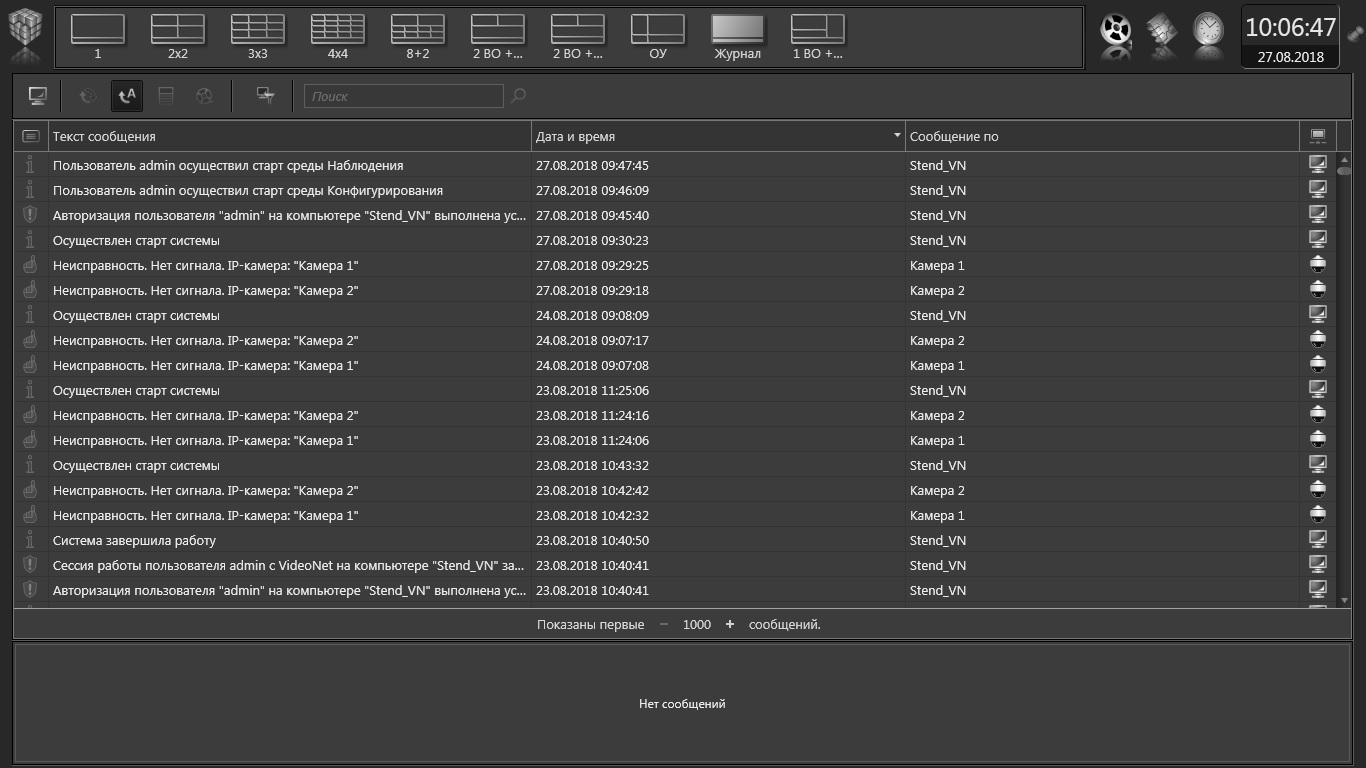
Flows from IP cameras from the DVR received:
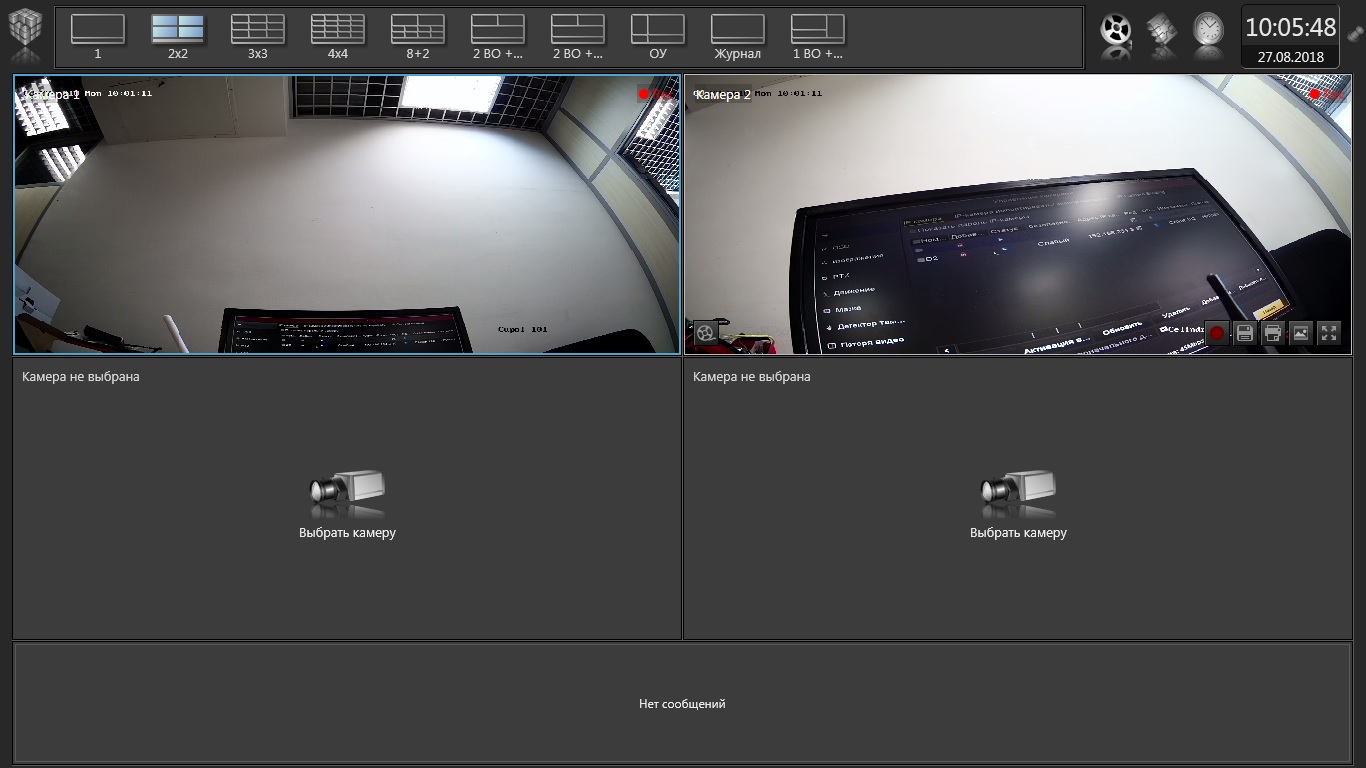
RTSP Tip:
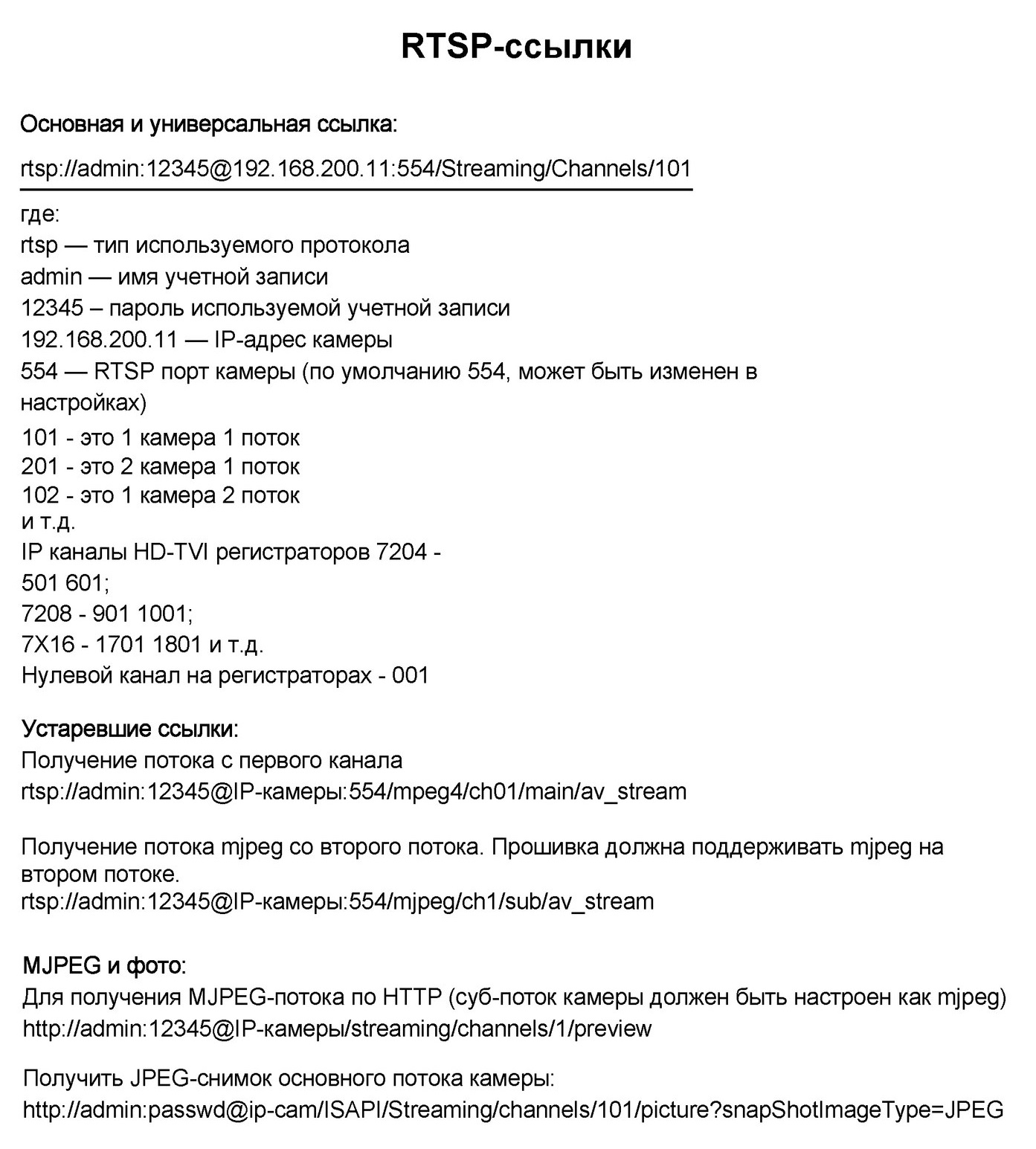
And now the most interesting thing is the autonomy of the IP cameras.
The test battery used is a Vision CP1250 battery (12V, 5Ah). The batteries are not new, but already used, they are more than three years old. New batteries will be on site (17 Ah and more)
We charge the battery:
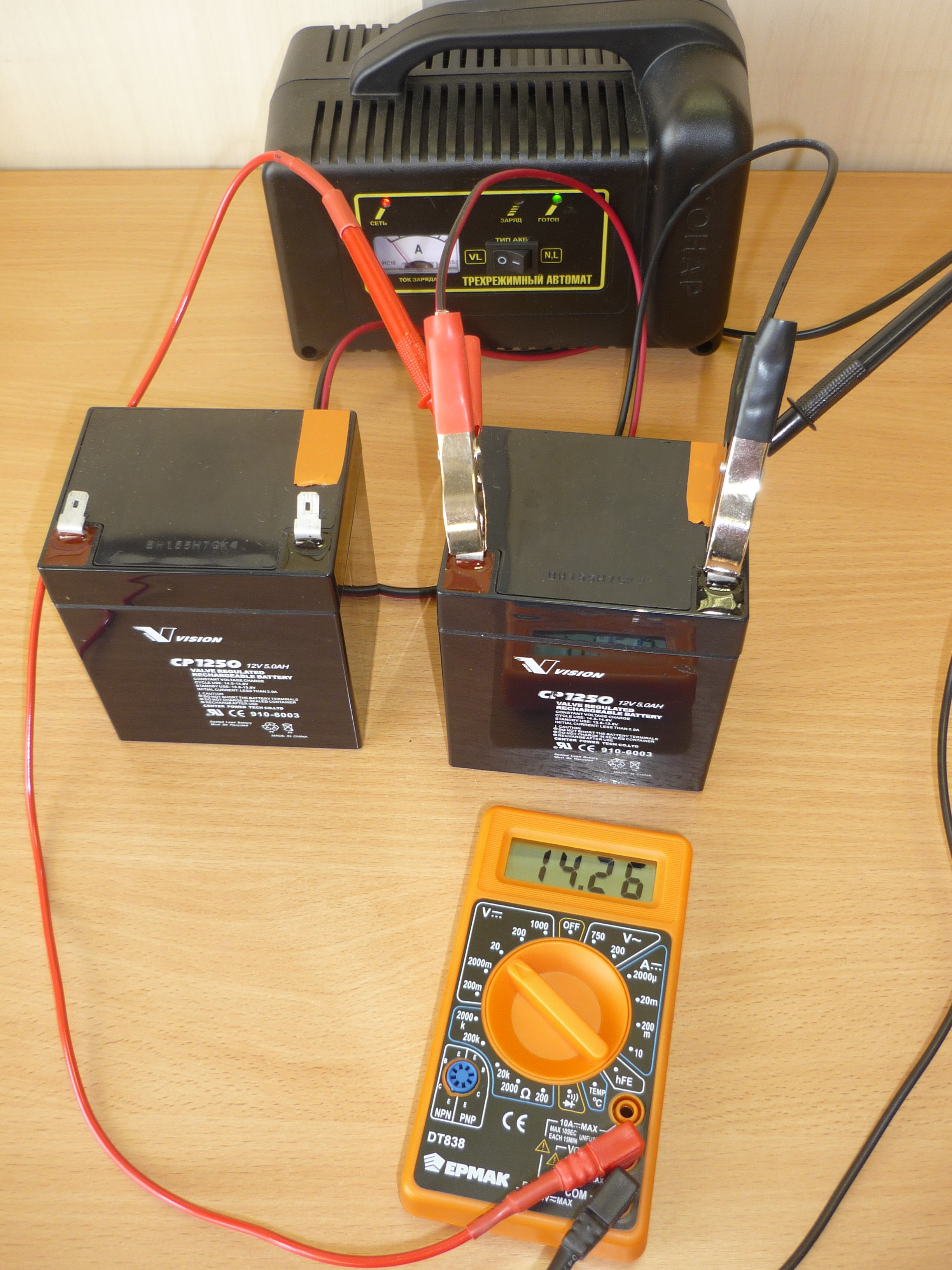
Checking:
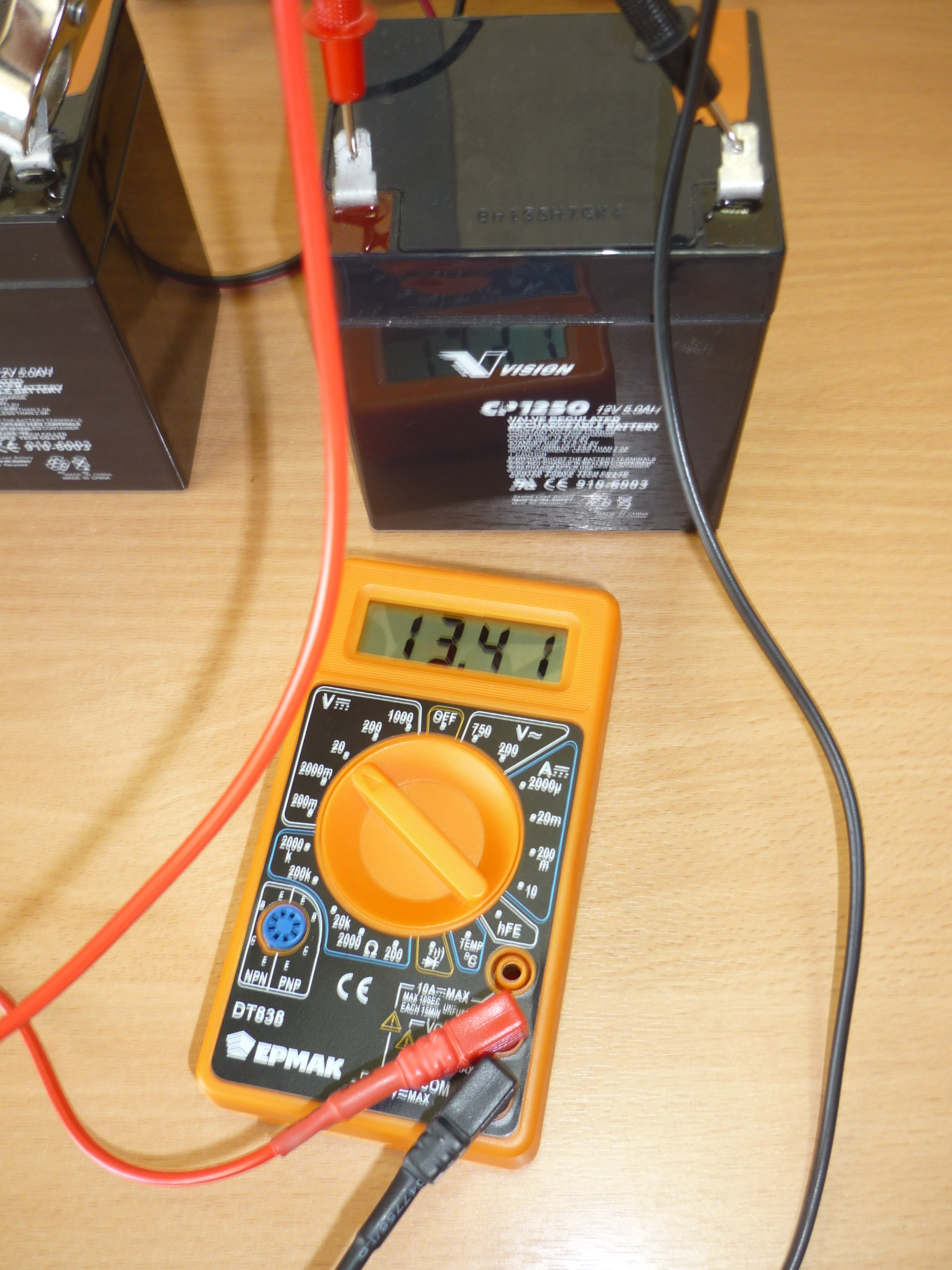
IP camera consumption data:

We measure the actual consumption of IP cameras:
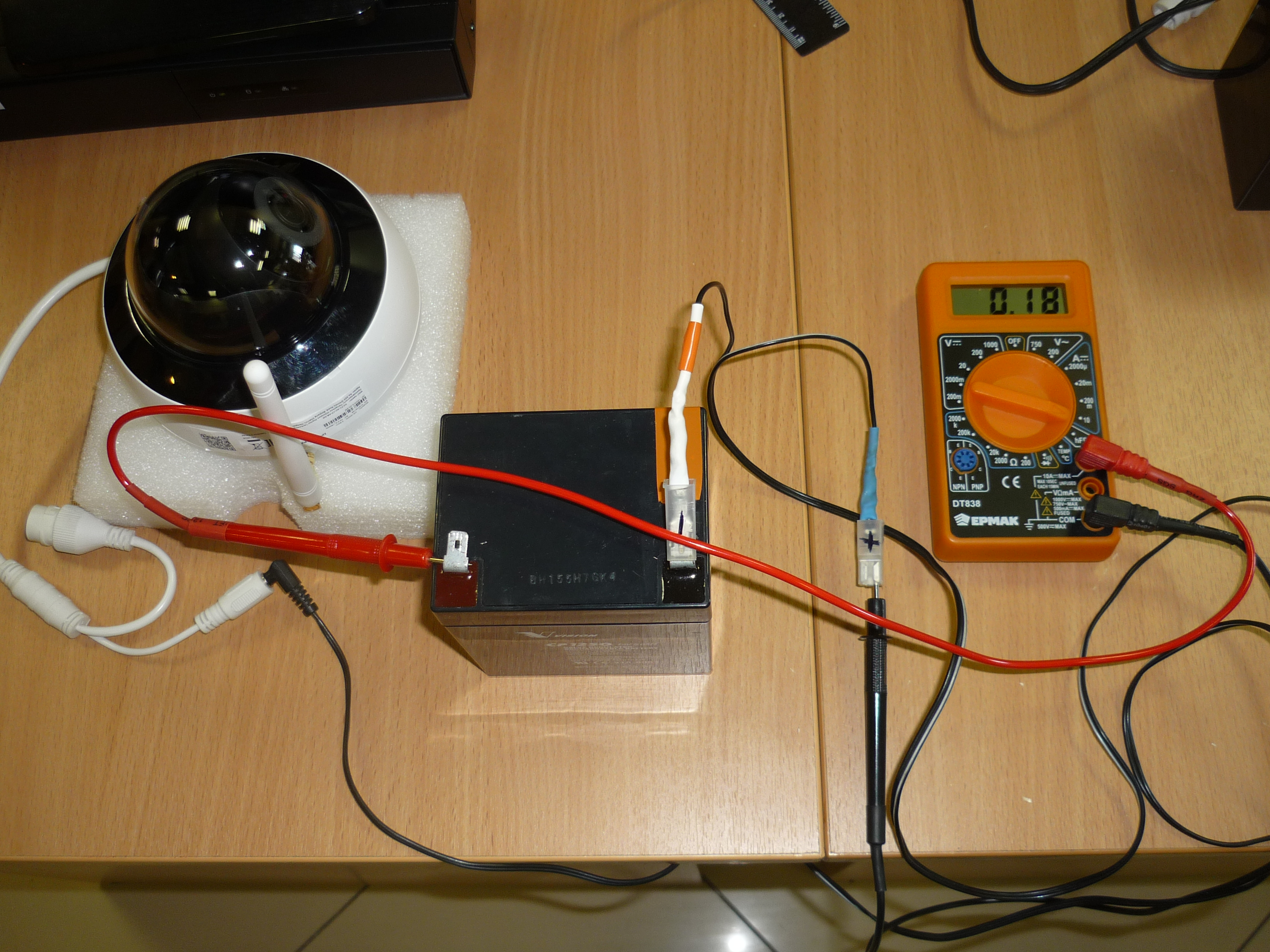

The result was:
At the dome camera, the consumption of the camera at 12V DC is declared by the manufacturer to be 400mA, the actual measured when working 160mA-180mA, when turned on up to 220mA.
At a cylindrical camera, the consumption of cameras at 12V DC is declared by the manufacturer to 400mA, the actual measured at work 140mA-160mA (from IR to 200mA reached peak), when turned on up to 210mA.
Tested offline battery life from the battery 5Ah (in the settings the maximum resolution + permanent recording to the recorder):
- DS-I252W dome - 12 hours;
- cylindrical DS-I250W - 16 hours.
It is planned to use a more capacious battery, of course, but in fact the maximum will be powered by power supply units, and in a place where it is not possible to organize electrical connection, cameras with batteries will be installed.
Battery status after disconnecting IP cameras:

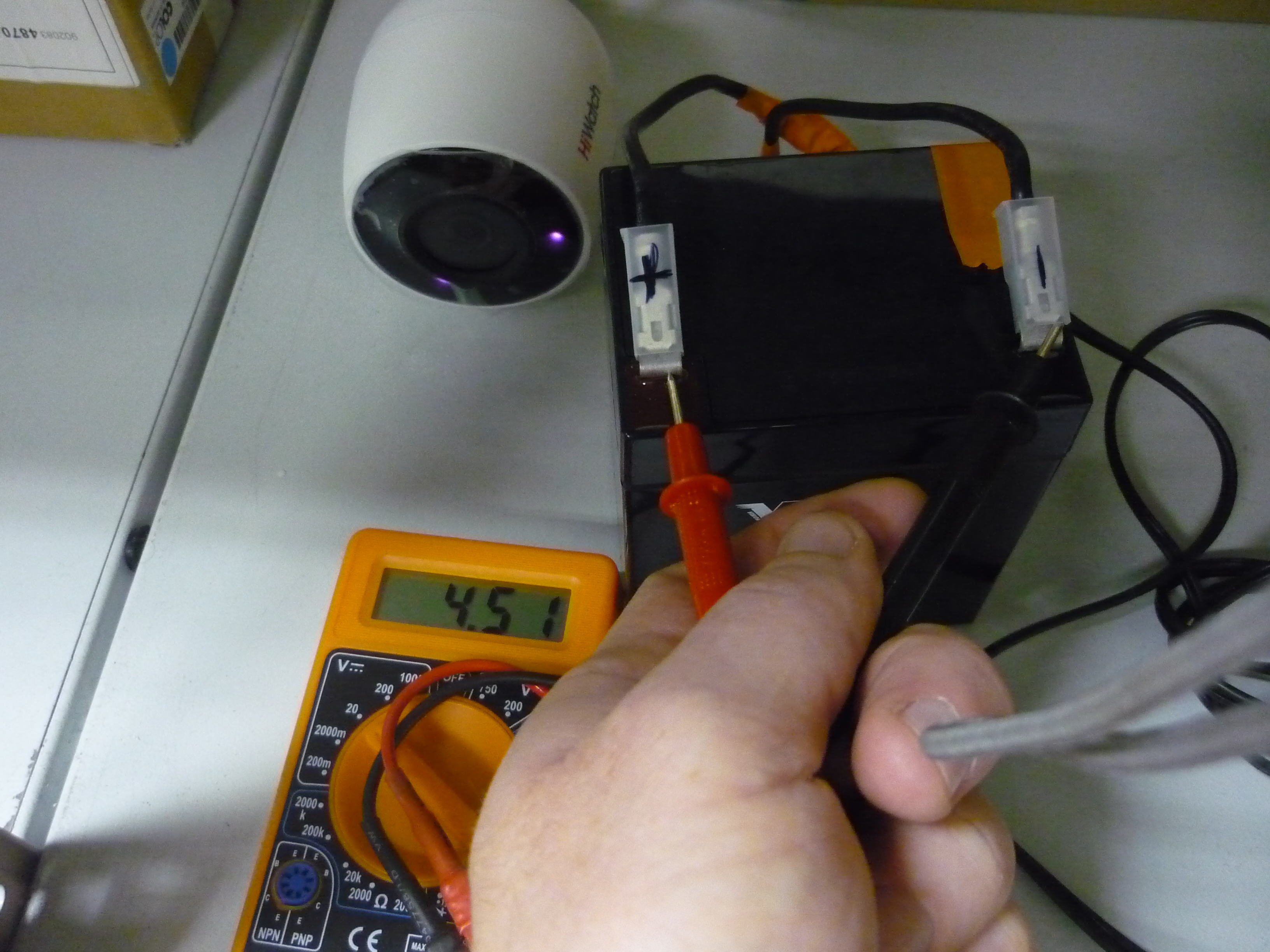
Recharge the battery:

Examples of frames from the video server.
Camera 1


Camera 2

Total
Pros: an inexpensive solution, the flow from the cameras quickly rises after turning off / on and easy to set up system.
Cons: security, can jam, easy to dismantle \ damage \ carry components, the question of lightning protection needs to be worked out.
Source: https://habr.com/ru/post/421591/
All Articles